- Skip to primary navigation
- Skip to main content
- Skip to primary sidebar
- Skip to footer
Yacht Cruising Lifestyle
Everything fun you can do from your yacht

Setting Up the Perfect Boat Galley
March 19, 2021 by Travis Turgeon Leave a Comment
Living on a boat comes with countless challenges, but few can cause more frustration than a poorly designed galley. It’s tough enough to cook a great-tasting meal that everyone enjoys in a standard kitchen, but managing that in a swaying, confined space with limited resources can make you want to hurl yourself overboard. A perfect boat galley is well-designed, highly functional, and safe to use. Below, we cover everything you’ll need to know to make the most out of your space.
The Boat Galley
Boat galleys vary in a ton of different ways. Size, layout, storage, proximity – the list goes on. Each boat will require a slightly different setup than the next, but certain features are beneficial across the board.
Boat Galley Basics
Boat Galley Location
From cooking and cleaning to remaining mobile and social, the location of a galley can dramatically impact your culinary experience at sea. The galley should be accessible from both the cockpit and saloon, well ventilated and in an area that is less prone to boat roll than other areas. Placement at the foot of the boat’s companionway is ideal, as it satisfies the three considerations mentioned above. Those with multiple roles on the boat will enjoy this location as they make trips above and below deck. Each boat will have a different setup, though, so be sure to consider the specifics for you and your crew. What works for some will be less than ideal for others.
Boat Galley Layout
The shape and layout of your space will dictate how you set up your kitchen and arrange your boat galley accessories. Three standard layouts for a boat galley exist – Linear, L-Shaped, or U-Shaped. L-Shaped and U-Shaped galleys are more commonly found on offshore cruisers, as the design provides more support and security when the boat is rolling. They also keep spaces and cooking accessories nearby for a busy evening as the lead cook.
While these confined layouts are more suitable for safety and convenience, they reduce the overall ability to be creative in the kitchen. Less space means you have to be more mindful of the equipment you’re using, as well as how many dishes you can prepare at once. It would be best if you determined your galley’s layout by evaluating how many people are on board, how often you’ll be cooking during open-water passages, and how creative a cook you are in the first place.
Functionality
Gimballed Boat Appliances
A gimbal is a single-axis support system on which objects pivot to stay level, even when their surroundings are not. Having gimbaled boat appliances is essential to cooking safely, especially when making long passages in inclement weather. The most common boat appliance to mount on a gimbal is a stove and oven. Gimballed boat appliances are lockable when not in use, so you can use the equipment as usual when at anchor or docked in the marina.
Logical Refrigeration Placement
While modern boat galleys are becoming more logical in their design and layout, there are often things that leave us scratching our heads when looking at older vessels. Unfortunately, one of the most common issues we see is the placement of refrigeration and freezer units. Whether due to space restrictions or simple neglect, we see these cooling units installed near engine rooms, ovens, or in areas with minimal ventilation. For obvious reasons, placement in these areas will drastically reduce energy efficiency and drive up costs. When looking to buy a used boat or renovate your existing galley, make energy efficiency a primary consideration.
Boat Galley Convenience Features
Double-Basin Sink
While this is, of course, a subjective opinion, many offshore cruisers prefer to equip their boat’s galley with a deep, double-basin sink. Deeper basins offer a few advantages, although not every person will see them as essential.
The main advantage is the ability to soak your dishes without worrying about water overflowing when the boat rolls. However, if you’re only cooking for a few people, you can manage this with a shallow sink as well. The selling point for most is the double basins. With two basins, you can use one for washing and draining while the other serves as a soaking station. After all, efficiency is the name of the game in such a small and limited cooking space. If you aren’t using one of the basins, you can increase your counter space by placing a fitted cutting board or surface over the second basin. Depending on the meal, you may require more space or an assistant in the kitchen.
Locking Cupboard, Drawer, and Oven Latches
Installing lockable latches to anything with a swinging door or a sliding drawer is the best way to prevent things from coming open during a passage. Not only are you risking breaking your kitchenware, but you’re potentially turning ordinary household items into dangerous, high-speed projectiles. These latches are cheap, easy to install and provide peace of mind for a more relaxed journey.
Vertical Cupboard Dowels
Another infinitely helpful boat galley accessory is vertical dowels, installations to keep glasses in place and prevent breakage. You can also use dowels to stack plates and bowls, although most find the best use for them to hold their precious wine glasses and beer mugs. Ensure you won’t be drinking your wine from plastic cups by installing these boat galley accessories in your cupboards.
Wall-Mounted Racks
Having wall-mounted racks in strategic locations around the galley can help the chef stay organized and uncluttered without sacrificing accessibility for items like oil and spices. If your wall rack doesn’t have a security band or horizontal dowel to keep items secure, you can easily install a bungee cord to keep things from moving around.
Boat Galley Safety Features
Grab Rails and Handles
When it comes to the boat galley, you need to consider safety a top priority. If not, you’ll quickly find out why this is such a pressing matter. One of the biggest threats to a cook is the prospect of being tossed across the galley. One of the best ways to prevent this from happening is by having handles and grab-rails within reach, although some prefer tether systems. The debate will likely continue through eternity, but most long-term cruisers seem to prefer handles and grab-rails as it keeps them mobile in case of emergency.
Tether System
Depending on who you ask, tether systems that hold a cook in place are extremely useful or extremely dangerous. Most seem to think they are more dangerous than beneficial, but those with knee or back injuries may find them invaluable in keeping them stable and safe in the kitchen. When cooking on a boat during a rough passage, being tied in place directly in front of hot liquids, fire and pans can be dangerous. If any of those things spill in your direction, burns and bruises are sure to follow. Handles and grab-rails are a common alternative to tether systems, but debates on a better design can become heated depending on who you ask.
Boat Galley Upgrade Considerations
Another method to improve refrigeration efficiency is to create an “organization plan.” Installing shelves and drawers will help with organization and space efficiency, and using color-coded labels can help with the quick identification of any item.
Hand and Foot Pump Faucets
Using your freshwater supply to clean dishes is far from economical, so installing a hand or foot pump to the faucet is a great way to minimize the use of your limited resources. Cleaning your dishes with seawater is not only easy, but the resources to do so are completely free. You can arrange hand pumps and foot pumps however you prefer, but a common method is to hook a hand pump to freshwater and a foot pump to seawater. Just clean your dishes with soap and saltwater, and give a quick rinse with fresh water to conserve your onboard resources. You can take the conservation efforts a step further by filling a spray bottle with fresh water to rinse dishes. Although a hand or foot pump uses minimal water, a spray bottle uses even less.
Stainless Steel Boat Appliances
Everything from your kitchen sinks to refrigerators and stovetops is subject to deterioration from salt while at sea. Most new vessels come equipped with all stainless steel appliances for just that reason, but certain models cut costs by supplying the galley with boat appliances made of other materials. If you have boat appliances or kitchenware constructed with anything other than stainless steel, it’s worth considering an upgrade. By spending money on items constructed with high-quality material now, you can avoid higher-cost replacements down the road.
Boat Galley Lighting
Poor lighting in your boat’s galley can create a dull and uninspired atmosphere, so upgrading your existing lights to LEDs can help liven the mood. Apart from your mental health, LEDs are far more efficient than standard bulbs, which reduces long-term energy costs. Consider installing additional lights to areas above the sink, stove, or countertops. Some LED lights can switch from red to white light, which is beneficial when setting the appropriate mood.
Port / Hatch Enlargements – Ventilation
Your boat’s galley is the space that needs the most ventilation – for comfortability, safety, and health. When cooking on a boat with propane, it’s crucial to have a well-ventilated kitchen space. Natural gases tend to be denser than air, which means that the gases will “fall” beneath the lower deck if a leak goes unnoticed. Once below deck, the heat can cause combustion to occur, endangering everyone on board or near the boat. Improper use of propane has killed and injured many cruisers in the past, so be sure to prepare appropriately if you decide to use propane as a fuel source. On that note, install gas monitors for further protection.
Galley Cookware and Accessories
With a small amount of planning and preparation, cooking on a boat in a small galley can be enjoyable. Some of the most important considerations to make are the essentials and non-essentials for kitchen cookware and boat galley accessories.
Boat Galley Essentials
Pressure Cooker
Pressure cookers are the perfect answer to your multi-purpose needs in a boat kitchen. With the steam vent left open, a pressure cooker serves as a standard pot for all daily meals you would prepare in a kitchen at home.
Closed, your cooking time decreases drastically, making those long-haul passages in inclement weather nothing short of a breeze. Although most people who venture into the cruising lifestyle don’t have a ton of previous experience with pressure cookers, the learning curve is exceptionally shallow. You can master it in nearly no time.
Nesting Pots and Pans
Dual-purpose kitchen cookware covers all of your bases without stocking up on too many unnecessary items. Further, having nesting cookware is the key ingredient in keeping storage space efficient and uncluttered. Simply put, nesting cookware cascades in size, allowing you to stack each item inside one another. Once you clean them, stack them together, and viola – efficiency at its finest.
Tin Foil and Freezer Bags
Two of the most challenging items to find in foreign countries, whether in the south Pacific or the Caribbean, are heavy-duty tin foil and freezer bags. Keeping your perishables fresh and delicious becomes extremely difficult without the proper boat galley accessories, and these two items are at the top of the list.
Anything and Everything Silicone
Silicone products are a full-time cruiser’s best friend, making life easy in a variety of ways. Silicone mats allow you to bake without using oil or parchment, are easy to clean, save on storage space, and provide slip-resistant surfaces for any area in the galley. Collapsible mixing bowls and measuring cups are unbreakable, light, and space-efficient.
Almost all silicone kitchen items can serve multiple purposes, as they are heat resistant, soft, and have gripping properties. Not only are silicone products highly functional, but they are also stylish and colorful – bringing even the dullest of kitchens to life.
High-Quality Knives
Having just a few high-quality, sharp knives on board makes a world of difference for the seasoned chef. In this case, quality over quantity has never been so important. Stainless steel material is the go-to in saltwater environments. High-quality knives make it easy to serve multiple purposes without sacrificing storage space or functionality.
Boat Galley Storage
Living on a boat will turn even the messiest of us into overly neat and well-organized human beings, but this only happens through trial and error without proper direction. Luckily, information is right at our fingertips these days.
Dry Storage
Storage Hammocks
Keeping dry goods such as fruits, vegetables, and spices in a storage hammock is a great way to conserve your cupboard space in the boat galley. Storage hammocks are just what you would imagine them to be. They are small, mesh nets that hang as a hammock does above your sink or stovetop – just try to keep them out of the way of cabinet doors and drawers.
Many experienced boat cooks keep the essential items here for easy access and quick use while preparing meals. The hammock swings just slightly when sailing through rough seas, but they are far from a nuisance if you install them in an ideal location.
Rotating Cupboard Shelves
Instead of pulling out every spice jar to reach the back of the cupboard, install a rotating shelf to make life easier on yourself. Emptying your whole cabinet during passage is a huge inconvenience, and keeping everything secure can become a hassle. You can install rotating shelves as multi-tiered vertical fixtures, so you can use each shelf to organize in a sensible way for your galley.
Refrigerator Storage
Knowing What Needs Cooled
Not all foods need cold storage for safe consumption. Having a good understanding of which items in your kitchen need cooling will save you space and energy, so familiarize yourself with the requirements of the foods you keep onboard.
Grains, rice, flour, fruits, vegetables, and many other items sealed in jars don’t need cooling for healthy consumption. Follow this LINK for estimated keep times of various food items commonly held on a boat.
Top-Loading Refrigerator
Generally, top-loading refrigeration units are open and empty spaces without bins or trays for a personalized organization. When people first try to figure out the best way to organize their cold foods, they often just stack things wherever seems easy and convenient. For most, this leads to developing bad habits that ultimately cost them money as they continually reduce their energy efficiency. We recommend using dividers, trays, and compartments to organize. Over time, you will learn to optimize your storage space – making life less stressful in the galley.
Freezer Storage
Color-Coded Mesh Bags
Having a storage system for your frozen goods is the best way to minimize the time that the freezer door stays open for unnecessary reasons. A standard method for doing this is to have color-coded mesh bags to store frozen items. When looking for fish, poultry, vegetables, or anything else, having a color system reduces time spent fumbling through storage looking for something specific.
Freezer Placement
When buying a new or used boat, your cooling units will likely already have a home. If you’re planning to replace or upgrade your freezer, however, install it below the waterline for a lower ambient temperature – this will help with energy conservation, especially in warmer locations like the tropics.
Keeping Pests Under Control
Cardboard and Paper Labels – Cockroaches
Cockroaches are among the biggest nuisances on a boat, especially when stocked with long-term provisions. Small spaces between cardboard mesh and underneath paper labels are the ideal breeding ground for cockroaches – the reason behind most boat infestations. Some cockroaches species carry egg capsules inside their bodies, and before dying, they release dozens of offspring. Getting rid of cockroaches is extremely difficult if not identified promptly. When provisioning, your best bet is to entirely remove any paper or cardboard from every item before placing your goods into storage. Once you remove the labels, use a permanent marker to indicate the contents of the container. Instead of using cardboard boxes as storage, invest in hard plastic tubs and trays to minimize the otherwise continuous battle. Air-tight bins and plastic bags are low-cost and efficient in keeping cockroaches at bay.
If you find yourself with cockroaches scuttling across your floors, you need to act quickly. While there are dozens of strategies for clearing your boat, each will require a different approach. Some cockroach species are easier to eradicate than others, and it seems that everyone has different results with the same methods.
Your best bet is to employ several of the following simultaneously:
- Cockroach Gel-Bait
- Poison Powders
- Fumigation When Necessary (this method requires you to vacate the vessel for 48 hours and remove any cookware, cutlery, and utensils beforehand)
Air-Tight Plastic Storage – Weevils
Weevils are another common onboard pest, and they can be majorly destructive to your provisions. Food items such as rice, nuts, flour, and beans can become infested quickly if not correctly stored in air-tight plastic containers. These foods act like magnets for weevils, and they are the perfect breeding ground for their nearly unnoticeable larvae. Even when treated with pesticides, things like flour provide the ideal habitat for weevil larvae to flourish.
If you are unfortunate enough to open up your grain or flour containers to find weevils, there are a couple of tried and true ways to get rid of the infestation. For flour, simply microwave the product for five minutes or longer, or bake it in the oven at 200 degrees F for 30 minutes. After heating, let cool before storing in an airtight plastic container and store with bay leaves to repel future weevils. For food items such as grains or nuts, you can place them in a deep freezer for several hours to several days. For the freezing method, you need to have a freezer that reaches temperatures well below freezing.
Keeping Clean – Ants
Whether on land or at sea, ants are among the most common pests in a kitchen environment. Sugary drinks, crumbs, and unattended spills are all reasons for ants to come aboard, so clean diligently everywhere on the boat – not just in the galley. You should take preventative measures before you ever see a single ant on the boat to ensure that a full-blown infestation doesn’t occur. Once ants make their way on board, you need to eradicate the problem at the source.
Preventative measures include:
- Creating Barriers on Dock Lines (Petroleum Jelly)
- Strategically Placed Ant Traps and Poisons in High-Risk Areas
- Whole or Ground Cloves Placed Near Sugar Containers
- Keep Sugars, Syrups, Honey, etc. in Sealed Plastic Bins
You can manage an existing ant infestation in various ways, although using several of the following methods at once is e asy and effective:
- Poisons (Borax and Sugar Mixture)
Galley Cookbooks
The Boat Galley Cookbook: 800 Everyday Recipes and Essential Tips for Cooking Aboard, by Carolyn Shearlock
The space is tight, the ingredients are limited, and you just caught a fish you’ve never even considered preparing before. The boat-friendly recipes and tips in this book are sure to help out any long-term cruiser in the galley, but especially the unseasoned, first-time liveaboard chefs. In some parts of the world, chickens come whole, fish come uncleaned, and you need bones for your broth. Making bread and yogurt can also be a daunting task with limited resources. Taking raw, simple ingredients and turning them into full-blown authentic dishes inspired by cuisines worldwide is easy with this galley cookbook. Make sure this book is onboard – you’ll find plenty of uses for it.
Feasts Afloat: 150 Recipes for Great Meals From Small Spaces, by Jennifer Trainer Thompson
This book addresses one of the biggest problems with cooking on a boat, and it mentions it directly in its title – limited space. While other boat galley cookbooks try to create complex recipes with unusual ingredients and specialized cookware, this book takes a different approach – bringing you straightforward, easy-to-cook meals without sacrificing taste or quality. You can cook a new boat-friendly recipe from this book every day for nearly half a year, although you are sure to find a few weekly staples along the way. The printed, high-quality color photos inspire the boat chef and create a mouthwatering appetite for everyone on board. If you only keep a couple of cookbooks on board, this should be one of them.
* For a complete list and description of our favorite books to help you plan, prepare, and execute a life of cruising, follow this LINK !
Galley Tips and Tricks
- Before preparing a meal, take out every ingredient you’ll need and situate them in a way that will maximize workflow. Fumbling through your cramped and limited storage becomes frustrating when you need something at a moment’s notice.
- Decide on the items you find most useful, and make sure you have them with you – even if it means sacrificing a bit of storage space. If you eat vegetables with every meal, you can reduce the time spent in front of your cutting board by buying a heavy-duty hand dicer. If you’re a skilled fisherman and eat seafood often, having a vacuum sealer can be a lifesaver. Tailor your kitchen equipment directly to your needs, rather than using the “blanket method” for preparation.
- If you don’t have silicone mats, use damp towels to prevent plates and bowls from sliding across surfaces. You can take this idea a step further by applying a small amount of rubber cement to the bottom of plates and bowls. Once dried, few materials will grip surfaces more tightly.
- Wear a full-length apron to ensure that you won’t suffer burns if hot liquids spill as the boat rolls during passage.
- Old tube socks serve as excellent protection for precious wine and liquor bottles. Some will choose to invest in proper fixtures to make sure breakage does not occur, but you can just as easily prevent this from happening with towels and socks.
- When preparing freshly caught fish, the smell on your hands may linger for hours or even days. Washing your hands with vinegar is a sure-fire way to get the odor off right away.
Want to join the new forum at #BoatLife? Get a conversation started by leaving a question or comment for the community!
If you found this article helpful, please leave a comment below, share it on social media, and subscribe to our email list.
For direct questions and comments, shoot me an email at [email protected]
Sharing is caring!
Reader Interactions
Leave a reply cancel reply.
Your email address will not be published. Required fields are marked *
Save my name, email, and website in this browser for the next time I comment.
MB #20512 PO BOX 480 Sevenoaks Kent TN13 9JY
Tel: +44 56 0386 9163
Keep In Touch
Thank you for reading.
Join our online crew and find more about the #boatlife
How to organize your galley for maximum efficiency
"An organized galley is the heart of a boat, where you'll be preparing meals, storing food, and spending quality time with your loved ones. Discover tips and tricks to maximize efficiency and make meal prep and family time a breeze."
How to Organize Your Galley for Maximum Efficiency
Sailing the open seas with your family is an incredible experience, but it also comes with its own set of challenges. One of the most important aspects of living on a boat is ensuring that your galley is organized and efficient. After all, the galley is the heart of your boat, where you’ll be preparing meals, storing food, and spending quality time with your loved ones.
In this article, we’ll explore various tips and tricks to help you organize your galley for maximum efficiency. We’ll cover everything from storage solutions to layout ideas, ensuring that your galley is a functional and enjoyable space for your family.
Assessing Your Galley Space
Before diving into specific organization tips, it’s essential to assess your galley space and determine what you’re working with. Consider the following factors:
- Size: How much space do you have in your galley? This will determine the types of storage solutions and appliances you can incorporate.
- Layout: Is your galley an open or closed design? This will affect how you organize your space and the flow of movement within the galley.
- Appliances: What appliances do you have or plan to have in your galley? This will impact your storage needs and overall organization.
Once you have a clear understanding of your galley space, you can begin to implement organization strategies that will maximize efficiency.
Storage Solutions
One of the most critical aspects of an organized galley is having ample storage for all your cooking essentials, food, and dishware. Here are some storage solutions to consider:
1. Utilize Vertical Space
Maximize your galley’s vertical space by installing shelves, hooks, and racks. This will allow you to store items above countertops, freeing up valuable workspace.
- Shelves: Install shelves above your countertops to store frequently used items like dishes, cups, and spices. Adjustable shelves are a great option, as they can be easily reconfigured to accommodate different-sized items.
- Hooks: Use hooks to hang items like pots, pans, and utensils. This not only saves space but also makes these items easily accessible.
- Racks: Install racks on the inside of cabinet doors or on the wall to store items like cutting boards, baking sheets, and lids.
2. Opt for Stackable Containers
When it comes to storing food and other supplies, opt for stackable containers that can be easily nested together. This will save space and make it easier to find what you’re looking for.
- Food Storage: Use airtight containers to store dry goods like pasta, rice, and cereal. These containers will keep your food fresh and prevent spills.
- Dishware: Choose stackable dishware like plates, bowls, and cups. This will save space in your cabinets and make it easier to access your dishes.
3. Use Drawer Organizers
Drawer organizers are a simple yet effective way to keep your galley organized. They can be used to store utensils, spices, and other small items.
- Utensil Organizers: Use adjustable drawer organizers to store your cutlery and cooking utensils. This will keep your drawers neat and make it easy to find what you need.
- Spice Organizers: Store your spices in a drawer organizer to keep them organized and easily accessible. Opt for a tiered organizer to make the most of your drawer space.
4. Incorporate Multi-Functional Furniture
When space is limited, multi-functional furniture can be a game-changer. Consider incorporating furniture that serves multiple purposes, such as:
- Folding Tables: A folding table can be used for meal prep, dining, and even as a workspace. When not in use, simply fold it up and store it away.
- Storage Benches: A storage bench can be used for seating and also provides additional storage for items like blankets, linens, and extra dishware.
Galley Layout Ideas
An efficient galley layout is crucial for maximizing your space and ensuring a smooth workflow. Here are some layout ideas to consider:
1. The Work Triangle
The work triangle is a classic kitchen layout concept that can also be applied to your galley. The idea is to create a triangle between your three main work areas: the stove, sink, and refrigerator. This layout promotes efficiency by minimizing the distance between these areas, making it easier to move between tasks.
2. The Galley Layout
The galley layout is a popular choice for boat galleys, as it makes the most of limited space. This layout features two parallel countertops, with appliances and storage on both sides. This creates a central aisle, allowing for easy movement between work areas.
3. The U-Shaped Layout
If you have a larger galley, consider a U-shaped layout. This design features three walls of countertops, appliances, and storage, creating a highly efficient workspace. The U-shaped layout also provides ample storage and counter space, making it ideal for families.
Additional Tips for an Organized Galley
Here are some additional tips to help you maintain an organized and efficient galley:
- Label Everything: Use labels to clearly identify the contents of your containers, drawers, and cabinets. This will make it easier to find what you need and prevent items from being misplaced.
- Keep a Minimalist Mindset: When living on a boat, it’s essential to be mindful of the items you bring on board. Stick to the essentials and avoid cluttering your galley with unnecessary items.
- Clean as You Go: Make a habit of cleaning up as you cook and put items away immediately after use. This will help maintain a tidy and organized galley.
Organizing your galley for maximum efficiency is crucial for a comfortable and enjoyable sailing experience. By implementing the storage solutions, layout ideas, and additional tips discussed in this article, you’ll create a functional and organized space that will make meal prep and family time a breeze. Happy sailing!

The global authority in superyachting
- NEWSLETTERS
- Yachts Home
- The Superyacht Directory
- Yacht Reports
- Brokerage News
- The largest yachts in the world
- The Register
- Yacht Advice
- Yacht Design
- 12m to 24m yachts
- Monaco Yacht Show
- Builder Directory
- Designer Directory
- Interior Design Directory
- Naval Architect Directory
- Yachts for sale home
- Motor yachts
- Sailing yachts
- Explorer yachts
- Classic yachts
- Sale Broker Directory
- Charter Home
- Yachts for Charter
- Charter Destinations
- Charter Broker Directory
- Destinations Home
- Mediterranean
- South Pacific
- Rest of the World
- Boat Life Home
- Owners' Experiences
- Conservation and Philanthropy
- Interiors Suppliers
- Owners' Club
- Captains' Club
- BOAT Showcase
- Boat Presents
- Events Home
- World Superyacht Awards
- Superyacht Design Festival
- Design and Innovation Awards
- Young Designer of the Year Award
- Artistry and Craft Awards
- Explorer Yachts Summit
- Ocean Talks
- The Ocean Awards
- BOAT Connect
- Between the bays
- Golf Invitational
- BOATPro Home
- Superyacht Insight
- Global Order Book
- Premium Content
- Product Features
- Testimonials
- Pricing Plan
- Tenders & Equipment

The design trends shaping superyacht galleys
Foodies rejoice: cooking on board is taking centre stage, says Tory Kingdon as she discovers the design trends shaping superyacht galley kitchens in 2021
Once upon a time, the galley was a somewhat overlooked element of a superyacht’s general arrangement and design. Primarily used by crew, they would be installed as a rather uninspiring functional element, with the budgets and big ideas reserved for owner areas. In recent years, however, they are finally getting the attention they deserve. After all, if a yacht is to offer five-star hospitality, it needs optimal kitchen equipment and space. Even the best chefs in the world cannot operate without the right tools.
The evolution of the onboard galley has undoubtedly been in line with the rise of the dining scene globally. Just as the world’s best restaurants started putting their chefs on show behind glass screens or in open kitchens, so too did superyachts begin integrating their cooking and dining spaces. Sanlorenzo’s SX88 , designed by Piero Lissoni and launched in 2017 , featured an entirely open kitchen next to its dining room. The idea was for a relaxed social space. “I keep picturing boats, even very large ones, as if they were lofts: that is very open, highly liveable spaces, which make it possible to be in contact with what’s around us” says Lissoni.
Ewa Eidsgaard , designer and director of Harrison Eidsgaard , agrees it’s a growing trend. “We’ve certainly had a lot of requests for more open kitchens, where guests can see their food being prepared by the chef, or can even allow for the client to do some of the cooking themselves. I think overall the attitude to food and culinary entertainment on board has changed over the last years. We’ve moved from classical dining to chef’s tables, hot stone grills and tapas-style sharing plates,” she says.
On yachts, where closed galleys exist, additional equipment is often brought outside to exterior spaces. The teppanyaki grill, originally a Japanese style of cooking, has become one of the most popular additions to superyacht sundecks and other al fresco dining areas in recent years. The hot griddle allows chefs to cook a selection of meat, fish and vegetables in front of the diner to be served immediately. Then there are barbecue grills and pizza ovens, like on the bridge deck of Benetti’s 69-metre Spectre . Dining is no longer simply a matter of eating, but a culinary experience that provides a large part of the evening’s entertainment.
One of the most impressive yachts to grace the charter market of late is 136-metre Lürssen Flying Fox – and it would be fair to say that any and every culinary desire can be met on board. As well as a 10-door oven, pizza oven and two teppanyaki grills, there is a Brazilian churrasco grill and a Spanish Josper charcoal grill. “Whether you want sushi prepared in front of you, a lamb cooked on the rotisserie or fresh focaccia, it’s all possible. It’s the most versatile option out there as it really has all the equipment you could need,” says Judith Stewart, director at Imperial Yachts , who delivered Flying Fox with Lürssen . There is also a 24-seat dining table on board, so it’s certainly a charter for lovers of all things food.
Not all owners like to be continually catered for. “There is a downshift in attitude that sees many owners wanting to take a more hands-on role,” says Eidsgaard. “We are slowly moving towards ‘relaxed luxury’, where many owners enjoy the freedom of making their own coffee, breakfast or dinner. Shared crew and owner’s pantries as well as mini breakfast rooms are in demand.”
The 63-metre Benetti 11.11 is an example of this where the stone-clad cocktail bar and kitchenette on the upper deck allow the client to make their own food or drink by the pool. The galley of 11.11 is also spacious and includes a central island in the design comparable to a residential kitchen.
According to Eidsgaard, a popular addition to newer yachts are tasting tables. “These are often in the galley, right in the middle of the action, yet available only to the ‘inner circle’ and enhance family and personal time,” she says.
With owners spending more time in the galley, there is undoubtedly a greater focus on aesthetics as well as functionality, and there is no shortage of inspiring designs available for onboard kitchens. Linley recently launched the Odyssey kitchen, which it hopes will appeal to the yacht industry. Currently on display at Harrods, the kitchen is hand-crafted from eucalyptus and sycamore. Its cabinets feature hand-dyed blue veneers and the brand’s signature marquetry details, and the worktop is a Bolivian marble with blue and gold veining. Bespoke brass accents complete the design.
Based in Minnesota, US, the family-run company Cambria makes beautiful and practical natural quartz stone worktops that are strong, more stain-resistant and non-porous than other stone surfaces. It has recently worked on yacht projects with Horizon , Ocean Alexander and Westport , and continues to bring new designs to its ever-growing collection of surfaces.
For the details there is no better place to look than the New York-based Nanz Company, which can create bespoke designs as well as offer a vast range of interesting and unique options for cabinet pulls, knobs and the like. Locking cremones are a mainstay of Nanz’s stable of products and it has recently released the elegant new No 7901 cabinetry cremone.
The more elaborate galleys become, the more technical pitfalls can arise. “From fire risk to extraction, odour residue or cleaning practicalities,” says Eidsgaard, “It all has to be dealt with. This is a trend that’s staying.”
This feature is taken from the October 2020 issue of BOAT International. Get this magazine sent straight to your door, or subscribe and never miss an issue.
More about this yacht
Yachts for charter, more stories, most recent, from our partners, sponsored listings.

Yacht Galley Design: A Challenge of Form and Functionality
Much like the kitchen in a home, which so often operates as the central hub, facilitating entertainment, homework, life chats, baking and cooking, the design of the galley aboard a yacht demands similar consideration. How many appliances and what type, prep areas, service areas for the crew, considerations for guest interaction… In my large Italian family, we always joked that every kitchen and yacht galley needed to have plenty of seating so we could hang out and harass the chef en masse! As with every space aboard a yacht, technical considerations drive all design to ensure functionality is maximized.
WHAT TO CONSIDER FOR YOUR YACHT GALLEY DESIGN
The yacht galley is a technical space; its purpose being to facilitate one of the most important onboard activities: the enjoyment of good food and good company. There are, of course, specific design/layout needs dictated by the vessel’s type and size: motor versus sailing, under 100 feet versus over 100 feet, the time spent at sea and in what conditions, and, of course, the yacht’s intended market – be it American, European, Australian or elsewhere. We dive a little deeper into this subject in our blog post about designing for the spec market . The main distinction that separates the boys from the men when it comes to galley design, however, lies between charter yachts and private yachts.

PRIVATE YACHT GALLEY DESIGN
Private yachts can get away with standard galleys designed to service small groups and families. Much like a home kitchen, the workspace and equipment – and even materials used – are adequate if they serve this purpose. High-end consumer appliances will suit, and good looking stone surfaces and backsplashes can provide lovely accents, even allowing the private yacht galley to become a focal point of the main living areas, with islands and settees providing a gathering spot for family and guests.

Exceptions to this rule are common, as we experienced with the design of the 120’ Nordhavn flagship, Aurora, aboard which the galley design served to influence much of the entire project . While the yacht was intended for private use, the owners were enthusiastic about entertaining and specified a functional galley fitted with the latest high-end appliances. The must-have appliance list was extensive: a full-height refrigerator and full-height refrigerator/freezer, two refrigerator drawers, two dishwashers, two ovens, a microwave oven, a steam oven, two sinks, a Salamander broker, an electric cooktop with four burners, a trash compactor, a BBQ grill, a teppanyaki grill and a wok burner, as well as plenty of storage and counterspace with a stool.
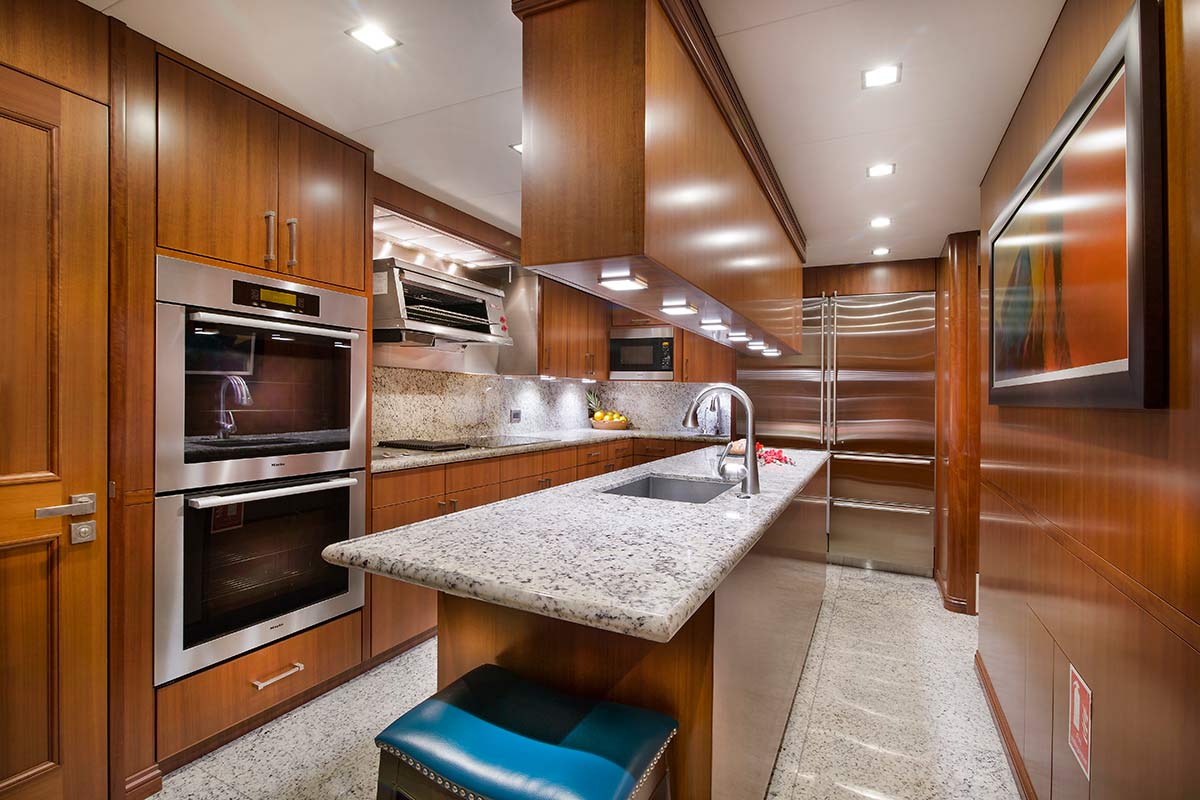
While there were some compromises to be made to accommodate all of this equipment while still allowing for enough countertop and cabinetry space, we executed a layout and combination of appliance/cabinetry design that suited their needs – and resulted in a truly exceptional, efficient galley space that would please any discerning chef!
We created a “second galley” in the enclosed flybridge space with a full bar with under-counter refrigerator/freezer drawers, a dishwasher, wine cooler, trash compactor and electric BBQ. In the end, this space became a coveted area in which the owners could cook and entertain while enjoying the water views.
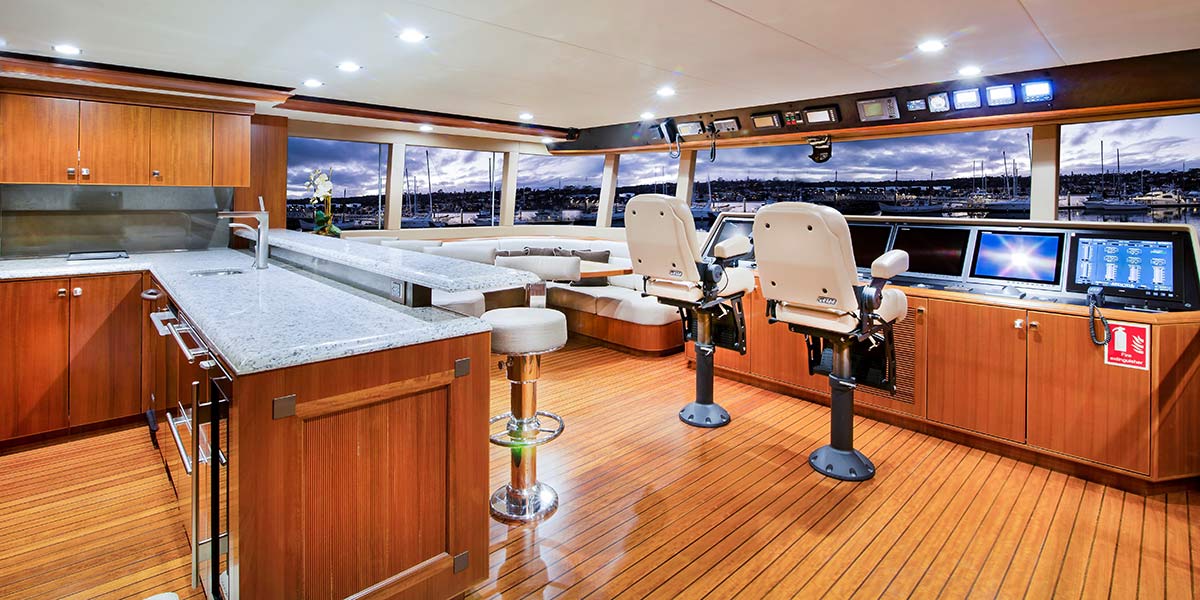
LIke Aurora, the owners of the 100’ Nordhavn, Serenity also love to cook and entertain and desired a Galley with all of the latest high end appliances along with enough space for his large family to congregate there. When designing the layout of Serenity , we extended it aft into the dining space, while still maintaining enough space in the adjoining Dining Salon to incorporate a large, 12-person dining table.
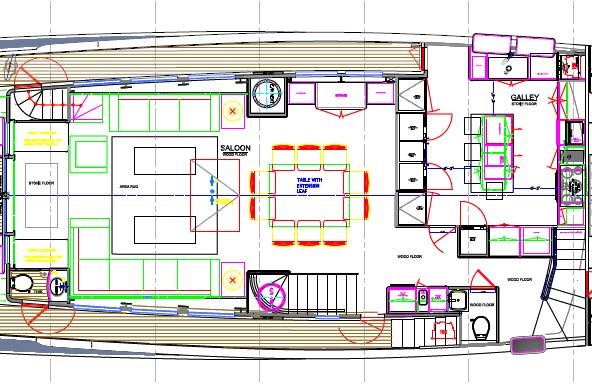
DESIGNING A CHARTER YACHT GALLEY
When your boat is intended for charter, the design needs are kicked up a notch…or more. Any owner who has experienced crew turnover will acknowledge that yacht galley layout plays a role in a chef’s job satisfaction. Dissatisfied chefs will blame designers who prioritized guest spaces over galley functionality. After all, food is the most important element of a successful charter. A charter necessitates not only three daily meals for up to 12 guests, but crew meals and snacks — not to mention separate dishes catering to dietary restrictions — cocktails, hors d’oeuvres, midnight snacks, crudités and more snacks, including a cookie or two.

KEEP YOUR YACHT GALLEY FAMILY-FRIENDLY!
Currently we are working on the refit of a 112’ Westport, Hannah, * which is planned for charter. The refit includes opening up the galley space to make it a more “family-friendly” gathering space. Because the yacht will be used for both charter and personal family use, it is important to execute a balance between the family’s appreciation for contemporary styling and high-end finishes and appliances and the durability and functionality required of a charter environment.
So, when considering your next design project, you may want to start with the galley. Do you have ravenous teenagers who must snack every half hour? Will you be joined by your large Italian family, each of whom must gather around the chef to critique the Sunday gravy? Do you have champagne tastes with a beer budget?
In the end, the balance of form and functionality are essential to a successful galley design. Designing your galley with the chef in mind — or better yet in consultation — will ensure not only a successful charter yacht with the right crew, but will also yield returns in resale.
*The new owner of the 112′ Westport Hannah , previously known as Via Kassablanca , was represented by Andrew Miles of Miles Yacht Group while the seller was represented by Alex Rogers & Walter Sea, Jr. of Westport Yacht Sales.
Leave a Comment Cancel Reply
Your email address will not be published. Required fields are marked *
Save my name, email, and website in this browser for the next time I comment.
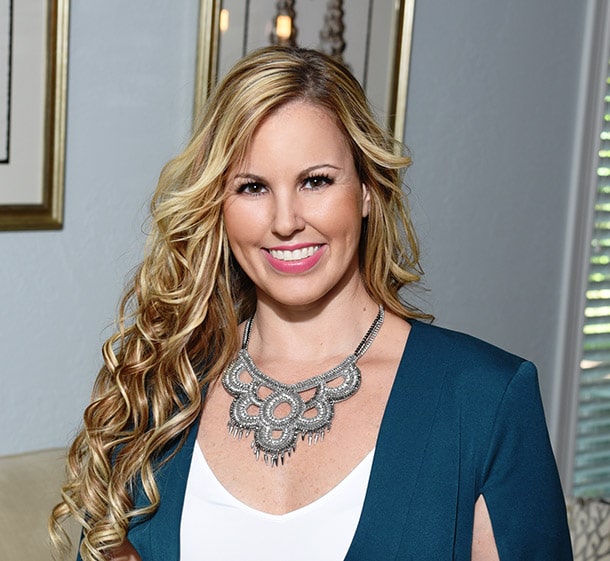
About the Author
Destry Darr Pethtel is an award-winning interior designer based in Florida. Her designs have been featured in several luxury yacht publications such as Showboats, Boat International, Yachts International, Yachting, Luxe Magazine to name just a few! Read More About Destry >>
As featured in:

destrydarrdesigns

© 2018-2023 Destry Darr Designs | Web Maintained by Clifton Design Group
Privacy Overview
- Types of Sailboats
- Parts of a Sailboat
- Cruising Boats
- Small Sailboats
- Design Basics
- Sailboats under 30'
- Sailboats 30'-35
- Sailboats 35'-40'
- Sailboats 40'-45'
- Sailboats 45'-50'
- Sailboats 50'-55'
- Sailboats over 55'
- Masts & Spars
- Knots, Bends & Hitches
- The 12v Energy Equation
- Electronics & Instrumentation
- Build Your Own Boat
- Buying a Used Boat
- Choosing Accessories
- Living on a Boat
- Cruising Offshore
- Sailing in the Caribbean
- Anchoring Skills
- Sailing Authors & Their Writings
- Mary's Journal
- Nautical Terms
- Cruising Sailboats for Sale
- List your Boat for Sale Here!
- Used Sailing Equipment for Sale
- Sell Your Unwanted Gear
- Sailing eBooks: Download them here!
- Your Sailboats
- Your Sailing Stories
- Your Fishing Stories
- Advertising
- What's New?
- Chartering a Sailboat
- Boat Galley
A Sail Boat Galley Layout for Offshore Cruising
A practical, seagoing boat galley is a vital element in all good cruising sailboats. And it's not just the quality and layout of the individual components that make up the galley, but also where it's situated in the boat itself.
Some people enjoy cooking on a sailboat. I don't - eating's more my thing.
For me, anyone that can conjure up a nourishing meal on a pitching, rolling boat is a treasure beyond value and should be cherished unreservedly.
And anything that can be done to make his or her life easier is likely to bring rich culinary rewards.
An efficient galley is a good place to start, the principal requirements for which are...
A Good Location for the Boat Galley
The location should be well ventilated and easily accessible to both the cockpit and the saloon. The common arrangement is for it to be at the foot of the companionway, and this has much in its favour.

This part of the boat is less prone to violent pitching, there's good natural ventilation through the companionway and hot food and drinks may be easily passed up to the cockpit.
There's not a lot you can do about the rolling, but the cooker should be gimballed on its longitudinal access which will largely take care of that.
Some centre cockpit boats that have a linear galley in the passageway linking the after-cabin to the rest of the boat, on the basis that there's not much else you can do with the space.
This is a less successful arrangement than those that have an L-shaped galley with the cooker and sinks in the conventional place, and only the work tops and refrigerator tucked into the passage way.

Another common location for a linear galley is forward, opposite the saloon seating.
Not the best place for it in my view - it's just too far from the main hatch.
The chance of getting a full mug of tea from the galley to the cockpit in anything of a blow is pretty slim.
Ventilating the Boat Galley
The cooking process, for those of you that aren't familiar with it, produces a deal of steam and heat which will create condensation and encourage the dreaded mildew.
An opening portlight or extractor fan above the galley will go a long way to relieving this unwanted side effect, if the ventilation provided by the companionway is insufficient.
A Good Working Layout for the Boat Galley

The three main units - cooker, sinks and refrigerator - should be close together so that the cook can reach all three without having to move more than a step or two, which is more easily achieved with a U-shaped or L-shaped galley than the linear arrangement.
A restraining harness should be rigged to secure the cook in close to the cooker when it's on the windward side of the boat, and there should be a stout metal bar across the front of the cooker to keep the cook from accidentally falling onto it when it's to leeward.
But beware! When secured by the harness, the cook has nowhere to go if he spills a pan of hot liquid, and many serious scalds have occurred this way. In boisterous conditions, it's a sound idea to wear a full length waterproof apron, or the lower half of your foulies.
There should be an adequate worktop area, with 3" (75mm) high sturdy fiddles, and a heatproof area to put down a hot pan.
Stainless steel sheet should be fixed to protect adjacent cabinetry and the hull side outboard of the cooker, as these surfaces can get very hot.
A good boat galley will have stainless steel dual sinks - one for washing, the other for draining. They should be deep enough (150mm to 200mm) to retain plates, and to prevent spillage when the boat rolls.
And it's no bad idea to have both a freshwater and a seawater supply at the sink. Just remember which is which when you're filling the kettle!
Other Plumbed-In Systems you may want to take a look at...
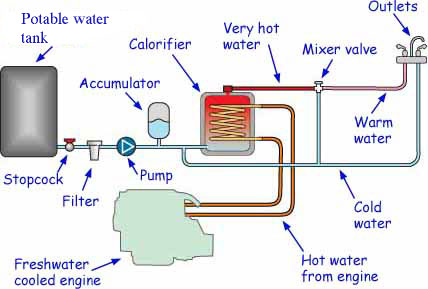
Fit A Boat Water Heater and Get Hot Water For Free!
Fitting a boat water heater is usually straightforward, and will supply free hot water via your engine's cooling system for a warm, refreshing shower. Here's how it works

Which Type of Boat Fridge Is The Most Efficient?
The top opening boat fridge is reputed to be more efficient than the front opening type, but that may not be the case - and here, amongst other boat refrigeration considerations, is why
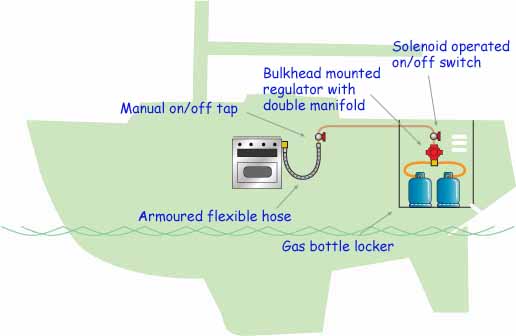
Not All Gas Boat Cookers Are Safe For Use At Sea
Good quality gas boat cookers go a long way towards protecting the cook from the very real risks of cooking at sea. Here are the essential safety features you should look for
Recent Articles
Amel Kirk 36 Sailboat Specs & Key Performance Indicators
Sep 07, 24 03:38 PM
Pearson 33 for sale
Sep 04, 24 03:29 PM
Apla 42 Sailboat Specs & Key Performance Indicators
Aug 30, 24 02:51 AM
Here's where to:
- Find Used Sailboats for Sale...
- Find Used Sailing Gear for Sale...
- List your Sailboat for Sale...
- List your Used Sailing Gear...
Our eBooks...

A few of our Most Popular Pages...

Copyright © 2024 Dick McClary Sailboat-Cruising.com
- BOAT OF THE YEAR
- Newsletters
- Sailboat Reviews
- Boating Safety
- Sails and Rigging
- Maintenance
- Sailing Totem
- Sailor & Galley
- Living Aboard
- Destinations
- Gear & Electronics
- Charter Resources
- Ultimate Boating Giveaway

Galley Klatch
- By Elaine Lembo
- Updated: July 28, 2010
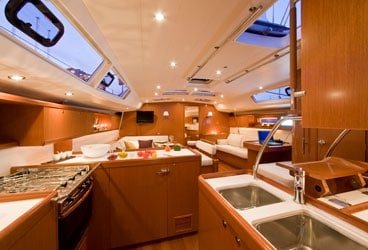
beneteau galley 368
It started with sea water standing in the galley sink. Each time Gwen Hamlin and Don Wilson’s Tackless II, a CSY 44 walk-through, sailed on port tack, the sinks backfilled if someone forgot to close the through hull. At anchor, they gurgled. A macerator installed in the sink’s exhaust line solved that.
While they were at it, and considering that they were about to head out on a 10-year sojourn through the Pacific Ocean, they ripped out the old sinks and installed a new, deeper, stainless-steel double. They also threw in a household pull-out sprayer faucet, molded countertops that shielded the oak joinery from stains, and a cutting board that fit over one of the sinks and could be slid from side to side while the boat was under way.
Moving on, they converted a starboard hanging locker to hold canned goods, had custom nesting box shelves built in to hold onions, potatoes, and tomatoes, mounted a microwave under the cockpit deck, and set up electrical appliances on an inboard ledge.
That work doesn’t even take into consideration a massive redesign, repurposing, and repowering of the fridge and freezer compartments.
Just as Gwen and Don wouldn’t head off with tattered sails or a natty inflatable, they wouldn’t dare overlook one of the most important components of their liveaboard boat-the galley.
Their vision would score points with any number of designers, fellow live-aboards, and builders who’ve spent time focused on the galley’s critical role, no matter what size the boat.
The refits that cruisers have undertaken, as well as the observations made by industry experts about layout, innovations, and improvements over the years, yield a hefty platter of points to consider when you’re contemplating your own refit project or boat-buying prospects.
A Sense of Proportion On the other end of the spectrum is Brandon Somers. who lives in the seaport village of Wickford, Rhode Island.
Somers, who grew up aboard the beefy 63-foot Lemsteraak Dutch sailing barge Brandaris, has chosen to downsize as an adult. With his sights set on cruising among southeastern New England’s anchorages and islands on overnights and weekend excursions, the 24-year-old Somers is midway through a complete refit of the modest galley on his 28-foot Pearson Triton.
As the plumber and mechanic for Jamestown Boat Yard on Conanicut Island in Rhode Island, Somers did his homework by photographing interiors of Pearsons he liked and had worked on.
Among the problems in the old galley? The starboard length of the saloon was entirely countertop, the boat lacked needed shelving and stowage, there was no table, and the icebox, with access from the cockpit, wasn’t really usable.
Among Somers’s additions are a two-burner stove, an accessible sink and icebox, a dinette that seats two, and a pressure water system. He’ll use propane for the stove and construct a deck box at the mast to accommodate the fuel source. And he’ll make a cushion/bunk on the starboard side of the saloon. “You need a place to sleep amidships,” he says.
A sense of proportion and creating a space that’s useful yet convenient are in line with Somers’ priorities, and it’s a wise choice as a project, according to designers and builders of leading production models.
A Designer’s Eye Apply methodical thinking to your situation, urges yacht designer David Pedrick. Pedrick’s prolific career has yielded such diverse results as America’s Cup racers and superyachts, restored one-off classics, and successful production models, including the Freedom 35.
“As with anything dealing with yachts,” he says, “space is precious. There’s never enough. You have to prioritize how to use space in a desirable way.”
The choices grow proportionately with size. A 30-footer is very limited, a 40-foot-plus boat gives you more latitude for, say, a three-burner stove with oven, and by the time you’re considering a 60-foot boat, cul-de-sac shaped galleys aren’t out of the question, Pedrick says.
With each incremental growth in boat size comes a threshold at which you have to think twice before adding the next amenity, yet even in a 30-footer, “you still want a sink that’s big enough to hold a pot or a dinner plate,” he says.
As amenities start to include things like microwaves and pressure water, Pedrick says, “You realize that it isn’t just galley space you need. You need power capacity, too.”
Real People, Real Numbers Typical cruisers sail about 10 percent to 20 percent of the time and spend the rest on the hook or in a marina. That realization in the last 20 years is what has largely influenced galley innovations, says Bruno Belmont, Beneteau Group Sailboats Development Director. With that title, Belmont’s been involved with oversight of designs for a wide range of Beneteaus as well as sailboats from Lagoon and Jeanneau.
“People used to comment about their sailing vacation by listing the number of miles sailed,” Belmont says. Acknowledging that actual miles sailed may be less in some cases made it possible to change perspectives about what a cruising sailboat should deliver, especially in the galley. Results have ranged from improvements in countertop surfaces and material to larger, more practical sinks, stoves and ovens of usable size, properly located lights, and last, but not least, practical and more energy efficient refrigeration. According to Belmont, refrigeration is the second biggest energy drain on a sailboat, after belowdecks lighting. ( “Reefer Madness”)
Adding that “a long battle has raged for years between front opening and top loading fridges,” Belmont says the end result is a stroke for power efficiency: front opening compartments for the refrigerator, and top loading compartments for freezers.
As well, Beneteau designers have improved the ability to use the galley under way, focusing attention on handrails, fiddles, hanging bars, and stove protection.
Housebroken Though the galley has always rated key consideration in sensible yacht design, changes over the last 25 years on the domestic front are influencing changes in the galley design, says Gerry Douglas of Catalina.
“It’s similar to what’s happened in houses,” says the Catalina corporate vice president and head of engineering. “Years ago, the galley was utilitarian. In some boats, the galley counter was actually a companionway step. Sometimes the galley was in the peak-if you had a paid hand.”
In residential design, Douglas says, the kitchen in the last 20 to 25 years has become a social space. More people are focused on food and food prep as a social activity.
“Food also takes on importance in cruising, and now the galley is front and center in the main cabin,” Douglas says, referring to changes in such newer Catalina models as the 445. “The cook’s at the sink and has eye contact with other crewmembers. The cook’s now engaged, looking into the main cabin, not with his or her back to the social space. It’s subtle, but important.”
While trends borrowed from home design enhance the galley experience, borrowing too much from designs meant for living on land can yield regrettable trends, he says, among them, “odd angles that don’t seem to make sense.”
“The galley is an interesting space-a combination of aesthetics and function,” he says, adding that the G, L, and J layouts give cooks a way to brace themselves under way.
Douglas’s enthusiasm for accommodating food preparation doesn’t include acceptance of all modern-day conveniences, like watermakers and microwaves. “Watermakers are like electronics,” he says. “They’re always getting better, cheaper, and easier to operate. Don’t buy one until you really need it. Also, realize that having one isn’t dependent so much on the size of the boat, but how much you actually use the boat.”
And, as for microwaves, “they’re the world’s most expensive bread box,” Douglas says, expressing his personal view, as microwaves are a feature that Catalina offers.
A Movable Feast Island Packet founder and designer Bob Johnson has a simple, direct way of expressing his priorities for the galley.
“If you’re going to cook a meal on a boat,” he says, “it should be like cooking a meal at home. Eating granola bars and drinking bottled water for days is not the way you want to go.”
That opinion and all it implies has guided the highly successful galley walk-in and walk-through variations Johnson has created for IP hulls in the 30 to 50 foot range. Besides the larger center cockpit models freeing up belowdecks space and sight lines nicely for the galley, while allowing “amazing walk-through space between counters,” all IP galleys, whatever the length, “must have working space for real people and all the safety considerations,” Johnson says.
And regardless of the make and model, even on a 30-footer, Johnson says, you need stowage for cutlery; dishes; dry storage; a good icebox either of one or two compartments; and a two-burner stove.
Expanding on signature must-haves (see his list), Johnson explains what goes into his thinking when it comes to the designing of IP galleys.
“It’s nice to be able to find the oil, have a place to chop vegetables, have the spices within reach,” he says. “I prefer to dry dishes and let them nest. You need a stove with a good oven. You need to be able to operate it safely, so it needs to be gimballed and you need to be able to strap yourself in with a harness. You can put a very large pot under the gimballed stove.”
And Johnson agrees with Catalina’s Douglas that the best in home-kitchen design can also find an appropriate corollary afloat. “Like a house, the galley is the central gathering point,” he says, noting with irony, “I eat better when I’m sailing than I do at home.”
“As a designer, cruiser, and onboard cook,” he says, “and knowing owners who enjoy cooking on board, it’s practical to consider these points.”
He Wrote the Book When Donald Launer got to his 17th sailboat, the bare fiberglass hull of a schooner, and was faced with constructing everything from scratch, he went looking for advice in his vast nautical reference library at home in New Jersey.
He couldn’t find much of anything written about galleys, either new or refit. The Galley: How Things Work ($18; 2009; Sheridan House) is his way of filling that gap, by documenting everything he did. It’s a thorough compilation of galley infrastructure and resources, materials choices, and galley hardware, from types of water tank materials to stoves, fuel, pumps, electrical requirements, as well as construction considerations.
“I had experience in putting things together,” he says. “It seemed appropriate to help others who were either modifying or building their galleys from scratch.”
Galley Classroom “Before you go cruising, it’s hard to imagine exactly what it will be like,” says voyager, author, and website creator Kathy Parsons.
“The galley is a real important part of the boat and a segue to learning about other things, like refrigeration and plumbing. This is a really great way for women to transition into the cruising life,” she says.
Besides creating the Women and Cruising website ( www.womenandcruising.com ) to address resources geared to female crew, Parsons interviewed 18 women solely about galleys. The result is a gold mine of advice and ideas about provisioning, what works when living aboard, what doesn’t, what they like, and what they’ve changed.
Many of the women, like Hamlin of Tackless II, undertook extensive refits and in at least one instance, design, aboard a variety of boats, from a 46-foot Crowther catamaran to a Whitby 42. Even in the most minimal of projects, recurrent themes and a few surprises emerge. One woman, a professional interior designer and the co-owner of the Crowther, lofted the galley on paper and then made a plywood and cardboard mockup to test usability of the new layout.
Aside from that owner, most of the women are aboard used boats. Their liveaboard priorities are strikingly in line with those of builders and designers of new boats: better, more efficient, front-loading refrigeration; more and accessible stowage; more counter space made of durable materials; roomier walkways to accommodate more than one person; stronger lighting and additional ventilation; range/stove hoods; filters for water taps; pressure water systems; eye contact with other crewmembers while cooking; and double sinks.
The main element of surprise is that these liveaboards, no matter what size the boat, altered galleys to accommodate a host of electrical appliances, particularly, microwaves. Read each woman’s account carefully and realize that a range of personal preferences and divergent opinions also emerge and influence their work. You’ve gotten a taste of valuable insights into galley refit and design. There’s only one thing left to say: Bon appetit!
CW deputy editor Elaine Lembo has earned her keep working in galleys luxurious and rudimentary throughout New England and Caribbean waters.
- More: DIY Sailboat Projects
- More How To


Grease the Wheels of Your Boat: A Guide to Proper Lubrication

A Bowsprit Reborn: A DIY Renovation Story

Rigging Redo: Our Switch to Synthetic

Top Tools for Sailboat Cruising: Must-Have Gear for 2024

Galápagos: A Paradise Worth the Paperwork

Around Alone

- Digital Edition
- Customer Service
- Privacy Policy
- Terms of Use
- Email Newsletters
- Cruising World
- Sailing World
- Salt Water Sportsman
- Sport Fishing
- Wakeboarding

- Charter & Brokerage
- Yacht Design & New Builds
- Tenders & Toys
- Superyacht Events Calendar
- Career & Training
- Departments
- Superyacht Crew Finances
- Sustainability
- Shipyards and Marinas
- Health & Wellbeing
- Polar Region
- Our Services
- Meet the Team
Superyacht Galleys: How do we build them better?
.png)
In the role of a Superyacht Chef, the working environment directly influences performance. With minimal space, it’s vital that a Superyacht galley is designed effectively. GN-Espace Systems specialise in yacht galley designs and are here to discuss how to make galleys better.
As shipyards and owners compete with each other to build the largest Superyacht, it is fair to say that the general mood amongst yacht chefs is a positive one. Larger Superyachts typically mean more room in the yachts’ working areas. And of course, this translates into bigger galleys with more storage spaces, tools, equipment, and so on.

Historically, in the days when a well-endowed yacht was just a shade over 50m, owners were reluctant to sacrifice living space for crew and other working areas. For example, if you step onboard a classic pre-1990 Feadship, you’ll often find a galley that largely represents a home-style kitchen with few mod-cons.
Let’s just say, cruising a Superyacht was a different game back then. There were fewer boats on the water and ample space in the marinas. Guests had fewer worries for safety and privacy, which made venturing ashore for restaurant meals more common.
However, fast forward to now and things have changed a lot, and guests look forward to indulging in luxury cuisine on board. The demand for this means Superyacht builders have to ensure the yacht galleys’ designs are a slick, near-commercial operation from the get-go.
So, what is important when designing the ideal yacht galley?

It doesn’t take a degree in architecture to dream up a functioning yacht galley space. But, equally, it would be foolish to address a layout without first consulting a professional yacht chef. Most of the chefs we spoke to during the creation of this piece agreed on one point…Professional consultationis the most important factor in making sure a new-build yacht galley meets its maximum potential.
Charter yachts will see stews and stewardesses having access to the yacht’s galley regularly. Because of this, it’s good to keep fast-moving traffic in mind when designing galley systems. Some chefs will say that this can be done by designing cooking equipment space, preparation areas and the overall chefs area at one end of the galley. While over the other side will be an area for collecting food/disposing of food. This is to reduce the hazard of crew and chefs getting under each other’s feet.
To further extend on galley equipment space – the majority of Superyacht galleys feature designs in which tools and applicants are out of the way under the counter and in cupboards. By doing so, it creates a larger work area.
“Space is the most important thing to get right in the galley. If the allocation of space isn’t quite right, this will have a knock-on effect on the overall design and working environment.” – Ralph Olingschlaeger, director at GN Espace.
Entrepreneur galley designer, Julian Kimberley and CEO of GN-Espace discloses:
There is still vast scope in the marketplace for specialist contractors in these types of working areas onboard yachts. This is evident through the success of similar businesses such as Superyacht gym designers Gym Marine , and yacht tender suppliers Superyacht Tenders. It’s a prime example that the industry is still very much willing to listen to experts.
Luxury blue water cruisers @Gunfleetyachts exhibiting in Hall 16 at @nonstopboat. Equipped with GN Espace galley. See us in Hall 11 F04 pic.twitter.com/wUbmSkQYiv — GN Espace (@GN_Espace) January 17, 2017
GN Espace has been operating in the Superyacht industry for over 10 years. They’ve overseen the evolution of Superyacht galleys, as yachts become larger and larger. From speaking with Julian, he uncovered that the yacht design industry has now embraced the idea of function-over-form. And, he goes as far as saying that this is the key to designing a first-class yacht galley.
“In the past, these galleys were designed as home-style kitchens, made to look beautiful with plenty of wood and marble. Practically speaking though these galleys are commercial kitchens nowadays, more akin to restaurant or hotel cooking facilities. This means that we are urging designers to include more surfaces and units in stainless steel. As well as to take more time studying the layout, to ensure better levels of food hygiene and efficiency.” – Julien
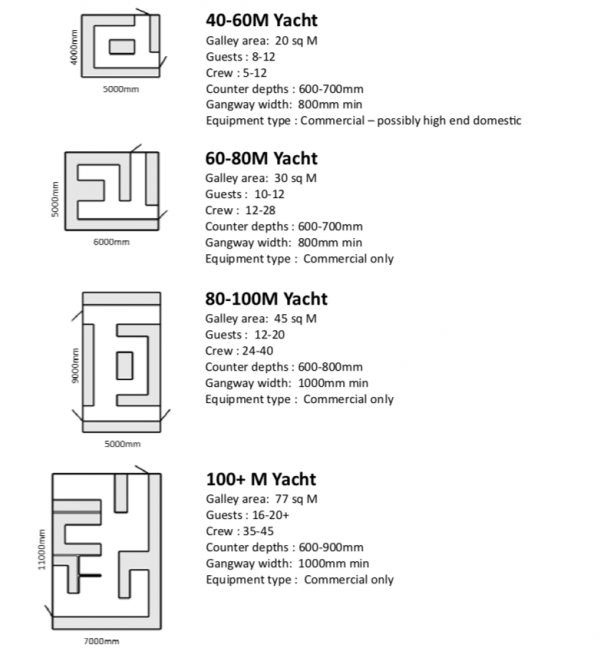
“Preparation is key. I ensure that at the beginning of the season or before a charter I stock up with just about every conceivable thing a guest could request. We have always been lucky to have ample freezer space and large dry stores on the yachts I’ve worked with. When I have been presented with tighter storage solutions, I have employed multiple-use pieces of equipment to make room for more provisions. Having the right ingredients is much more important than having a special gadget when space is at a premium” – Jules Wigley, a kiwi chef who has enjoyed a career cooking onboard some of the most high profile yachts in the Superyacht industry.
Whatever the future holds for the new-build market, one thing is for certain; Despite the importance of space in the galley design phase, it needs to be created with a technical mindset, as opposed to a style-driven approach.
Visit www.gn-espace.com for more on specialist yacht galley designs, systems and equipment.
For the latest crew mess news, click here.
Superyacht Content
Related articles
How does superyacht insurance work, anyway, mastering the art of patience. tips on dealing with difficult charter guests, champagne vs prosecco: what sets them apart, the world’s most unusual chef jobs. aka: culinary weirdos.

Popular Posts
- The Rise of Private Chartering in 2021
- Tender Of The Week: Castoldi JT21 Available To Reserve Now!
- Y.CO Prepare to Headsouth
- Marina Ibiza Use ‘Bio-Box’ To Slash Impact Of Yachting On Marine Environment
- The 5 best places to go cruising if you have a young family
Social media influencer and digital brand expert.
Superyacht Content brings you the latest in social news for the superyacht industry.
Keep up to date with us across our social channels, and don’t forget to hit that share button!
- Superyacht News
- Superyacht Jobs
- Superyacht Marketing
Join our Newsletter
- Your Name First Last
- Your Email *
Copyright © 2023 Superyacht Content | Website Design by Zonkey
Privacy | Credits | Get in Touch
- Skip to main content
- Skip to primary sidebar
- Skip to footer
The Boat Galley
making boat life better
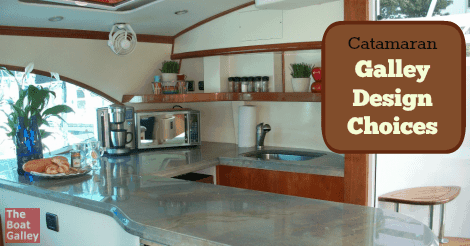
Galley Design Issues on a Catamaran
Published on July 18, 2014 ; last updated on June 12, 2020 by Carolyn Shearlock

Estelle Cockcroft, one-half of CatamaranGuru.com , wrote this guest post for The Boat Galley. If you’re thinking of buying a cat, be sure to read their Top 10 Tips for Buying a Catamaran .
Tips for the Best Boat Galley Designs for a Midsize Catamaran
Having lived aboard boats longer than I have lived in a house, I have prepped and cooked in my own galleys in 4 different boats. Serving as chef on various charter boats offered the opportunity to try quite a few galley configurations. So it is not surprising I have strong opinions of what styles and shapes of galleys work and which ones fall short. I tested my preferences when I was lucky enough to design my own galley for our current Prout 45 catamaran when it was built in Thailand. Being able to incorporate most of my requirements and wish list items, I have found it to be a simple, practical and easy-to-use area. You can see it in the photo at the top of this article.
Galley Up or Galley Down?
A major design question with regard to catamaran galleys is “up or down?” First, a look at a typical “galley up” configuration:
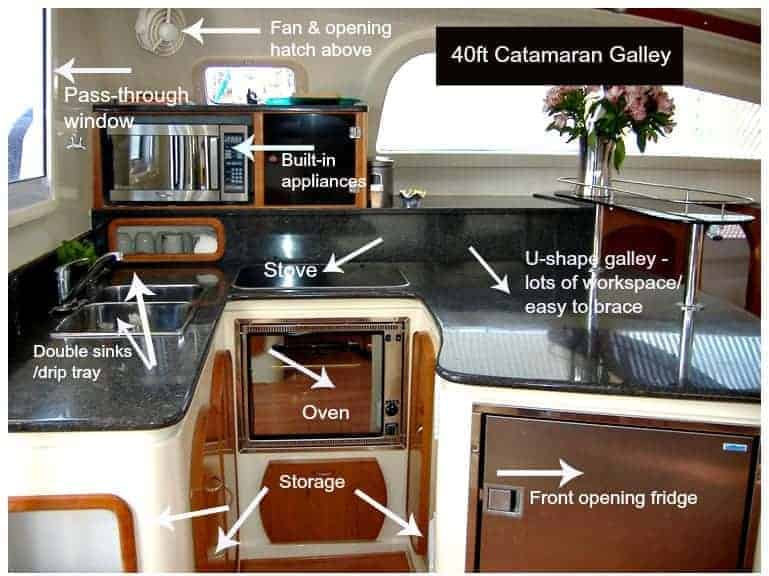
Why Galley Up?
In modern catamaran galley designs the most popular option is galley up (which I prefer for live-aboard). Having the galley located on the bridgedeck makes it a focal point of the main living and entertainment areas. The cook can socialize while keeping an eye on a meal’s progress. Also, having the galley on the same level as the serving area and cockpit is less tiring and safer than hauling hot food up stairs, especially when at sea. Another advantage to topside location of a galley is that it is usually better ventilated and easy to step out for air in the cockpit.
Why Not Galley Up?
When on charter, the galley up offers the chef no privacy and can become hectic when preparing meals. In some smaller catamaran designs, having the galley up can significantly impact the size of the saloon seating area. Also, in some configurations, sharing space with the chart table and having less storage can make galley up less appealing.
And now a look at a typical galley down configuration:

Why Galley Down?
Some catamaran galley designs like the Antares and St. Francis still offer the galley-down as standard configuration, but even they offer the ”up” version now. Galley down provides a private, self-contained galley with dedicated prep areas, which is ideal for chefs on charter boats. Some chefs contend that at the heat of the moment, they want to cook, not socialize! Private owners also like this in-hull galley design because it frees up the bridgedeck for an open, clean, and more spacious saloon area. Many designs in galley down offer more stowage and having the galley in the hull utilizes space that might otherwise be less efficiently used.
Why Not the Galley Down?
When at sea, every meal comes from the galley. So live-aboards spend a lot of time in the galley and many cruising couples and families find that the separation is not ideal. As previously mentioned, lugging hot food and beverages up and down stairs with unpredictable swells can prove dangerous. When provisioning, it takes a lot of trips in and out of the hull. Plus, the below-deck area can become very hot and stuffy with lingering cooking smells.
Tips for the Best Boat Galley Layout, Design and Appointments
For me, the most important feature for any galley on any boat is its functionality when at sea. Cooking when stationary is easy on any boat! A well-designed galley should be safe, well-ventilated and functional. I agree with this chef-captain that functionality is all about organization and efficiency:
“Organization goes hand-in-hand with efficiency.”
— Annie Mahle, chef-captain, schooner J. & E. Riggin
Galley Location
Galley location preferences are amidships or aft to reduce motion in galley down designs. If located in the saloon area, it should be close to the door for less motion, better ventilation and more headroom.
Galley Shape
The wrap-around or U-shape galley is ideal in my opinion. It allows for loads of counter space and offers the ability to brace oneself on the high seas. You need that even in a catamaran from time to time!
The fridge, sink, stove and prep areas should be close at hand with appliances well secured, if not built-in. Design of appliance interiors should prevent and contain spills. Top-loading fridges can be cumbersome, especially if it is part of your counter space, so I like front-opening fridges. In my experience, a top-loading freezer, when well organized, is easy to use. It can be tucked away under a seat or an out of the way place.
Stoves and ovens on catamarans are not gimbaled, so placing the stove on the inside of the U-shape, is ideal for safety. This reduces the risk of flying pots. Even on my catamaran, I prefer to use potholders to clamp pots down when at sea. Better safe than sorry! Our BBQ grill is a natural extension of the galley (another vote for galley up!). We invested in the best, biggest grill that we could semi-permanently fit on the rail. We use it all the time for grilling and baking, even desserts.
Most people prefer double sinks, but in tight galleys, I find one sink at least 10 inches deep is preferable. It takes up less space and easily accommodates bigger pasta pots, unlike the typical small double sinks on most boats. Locate the sink against the bulkhead that acts like a splashguard and use a collapsible basin to rinse in.
A Bonus Recommendation
A manual saltwater pump in the galley is useful in emergencies and a good way to preserve fresh water. Unfortunately few catamarans offer this option since watermakers make fresh water less of an issue.
Things to Consider
While catamarans generally offer more design options and do not have the same space constraints or heeling issues that monohulls have, they do have the weight issue. It is a constant process to guard against overloading a catamaran with too many gadgets, heavy stone counter tops (honeycomb cored materials are best), and nice-to-haves. Just because you have the space, does not mean you have to fill it up!
If you have not done so lately, re-visit Carolyn’s blog posts on galley storage . They are chock full of great advice and helpful hints to easier living aboard and galley cooking.
For more information on choices in galley design, read my post on “ choosing your boat galley design .”
Estelle enjoys sharing her experiences and knowledge gained from 20+ years as a live-aboard sailor. Having met the challenges of 50,000 ocean-going miles she has tales of nooks and crannies of the world unseen by many and can talk boats from stem to stern. As a qualified ASA captain and instructor, she helps tentative sailors take the plunge into the exciting world of sailing adventures.
Estelle shares her broad knowledge from boat building, to boat brokerage, to running a yacht charter business with anyone who wants help selecting a cruising yacht that meets their needs and achieves their dreams. She delights in connecting with the growing community of sailing women so connect with Catamaran Guru !

And check out our other courses and products

Find this helpful? Share and save:
- Facebook 376
- Pinterest 150
Reader Interactions
Colin Mombourquette says
July 18, 2014 at 11:06 pm
Goodness, the galley is bigger than my whole cabin
May 27, 2018 at 11:42 am
Thank you for sharing this information. We have galley down in our catamaran. I like that I have a lot of counter space and that I can brace myself easily when preparing meals and washing dishes underway. I have a small hatch directly above the galley in the cabin top which we typically leave open unless in heavy weather. It allows for ventilation and if it’s fairly good sailing conditions I open the port light over my sink to let more air in and toss out organics while I’m cooking (onion peels, etc). It also allows us more space in our salon – being a 35 foot catamaran that’s a good thing for us. But I think it’s all in what you’re used to. This is all we have ever known and it works well for us. 🙂
Gerrit Coetzee says
August 12, 2018 at 12:04 pm
Thanks for great suggestions. I agree and you mentioned all the things i had as concern. Also personally prefer gally-up, being a captain, but spending many an hour in the kitchen myself.
Dave Skolnick (S/V Auspicious) says
October 7, 2022 at 12:02 pm
I think Estelle left out some important factors important to offshore passagemaking. These will be less important to coastal cruisers.
Note that catamarans move. Unlike monohulls that mostly move in one axis, either roll or pitch depending on where the seas are coming from, catamarans almost always both roll and pitch. The relationship of those motions depends on the seas and the length-to-beam (L/B) ratio.
The lack of fiddles on countertops, shelves, and locker shelves is a major shortfall of just about every catamaran I have delivered.
The lack of pot holders on stovetops is a major problem.
Galley-up designs don’t have the ability to both cook or even make coffee while protecting the watch from light pollution and protecting night vision. This can be partially mitigated and moderate expense on most boats.
In my opinion, glass top stoves are a very bad idea on boats and no manufacturer takes appropriate measures to protect safety and operation.
Leave a Reply Cancel reply
Your email address will not be published. Required fields are marked *
Each week you’ll get:
• Tips from Carolyn • New articles & podcasts • Popular articles you may have missed • Totally FREE – one email a week
SUBSCRIBE NOW
- Questions? Click to Email Me
- Visit Our Store

- New Sailboats
- Sailboats 21-30ft
- Sailboats 31-35ft
- Sailboats 36-40ft
- Sailboats Over 40ft
- Sailboats Under 21feet
- used_sailboats
- Apps and Computer Programs
- Communications
- Fishfinders
- Handheld Electronics
- Plotters MFDS Rradar
- Wind, Speed & Depth Instruments
- Anchoring Mooring
- Running Rigging
- Sails Canvas
- Standing Rigging
- Diesel Engines
- Off Grid Energy
- Cleaning Waxing
- DIY Projects
- Repair, Tools & Materials
- Spare Parts
- Tools & Gadgets
- Cabin Comfort
- Ventilation
- Footwear Apparel
- Foul Weather Gear
- Mailport & PS Advisor
- Inside Practical Sailor Blog
- Activate My Web Access
- Reset Password
- Customer Service

- Free Newsletter

Catalina 270 vs. The Beneteau First 265 Used Boat Match-Up

Ericson 41 Used Boat Review

Mason 33 Used Boat Review

Beneteau 311, Catalina 310 and Hunter 326 Used Boat Comparison

Tips From A First “Sail” on the ICW

Tillerpilot Tips and Safety Cautions

Best Crimpers and Strippers for Fixing Marine Electrical Connectors

Thinking Through a Solar Power Installation

Polyester vs. Nylon Rode

Getting the Most Out of Older Sails

How (Not) to Tie Your Boat to a Dock

Stopping Mainsheet Twist

Fuel Lift Pump: Easy DIY Diesel Fuel System Diagnostic and Repair

Ensuring Safe Shorepower

Sinking? Check Your Stuffing Box

The Rain Catcher’s Guide

What Do You Do With Old Fiberglass Boats?

Boat Repairs for the Technically Illiterate

Boat Maintenance for the Technically Illiterate

Whats the Best Way to Restore Clear Plastic Windows?

Giving Bugs the Big Goodbye

Galley Gadgets for the Cruising Sailor

Those Extras you Don’t Need But Love to Have

What’s the Best Sunscreen?

UV Clothing: Is It Worth the Hype?

Preparing Yourself for Solo Sailing

How to Select Crew for a Passage or Delivery

R. Tucker Thompson Tall Ship Youth Voyage

On Watch: This 60-Year-Old Hinckley Pilot 35 is Also a Working…

On Watch: America’s Cup

On Watch: All Eyes on Europe Sail Racing

Dear Readers
- Belowdecks & Amenities
Design for A Portable Galley

I’ve always loved small boats: day sailors, trailer sailors, runabouts, and skiffs. In many ways they give the most joy for the limited time most of us can spend on the water. While not cruisers in the usual sense of the term, it’s often pleasant to spend a night or weekend aboard a small boat, especially if you are young, flexible and unarthritic. A couple of sleeping bags and air mattresses, a tent over the cockpit, and a galley add up to happiness and freedom for the young and young at heart.

It’s that last item on my list-the-galley-that I want to look at this month. On an open boat there’s no place for a permanent galley. Even with a cuddy on a trailer sailor, a permanent galley is seldom an effective use of space. Hence, the portable galley which can be stored away or even left at home when not in use is the answer for the smaller boat.
The drawing shows one idea for a portable galley. As you can see, it holds a gas camping fry pan, and sauce pans with removable handles, a real coffee pot (an imperative for my wife and me), plates, mugs, cutlery, etc. Anyone planning a portable galley will have to work out his own dimensions based on the sizes and complexity of the outfit chosen. Use the drawing as a starting point for your own design.
The construction I suggest goes as follows. For the main structural panels of sides, top, and bottom, use 3/16” or ¼” waterproof plywood. For backing the joints use 3/8” or quarter round, as shown in the drawing. Brass brads and epoxy adhesive would be a good combination for sticking the whole thing together. If, however, you plan to varnish the unit, you might wish to try urea resin glue. This is the stuff you buy in hardware stores as “plastic resin glue”. It comes as a powder which you mix with water to form a thick syrup, and while not boil proof, it’s effectively water resistant and perfectly satisfactory for jobs like this where the finished product won’t be submerged for long periods of time.
Urea glue is cheap: and best of all for something you intend for varnishing, it cleans up with water if you catch it before it sets up.
I’d suggest two or three short brass flat hinges for the cover, and a trunk latch or turn button hasp to keep the box closed.
Rope handles are shown. They can be easily installed by drilling appropriately-sized holes in the box sides, threading the rope through and tying stopper knots on the inside. You might even consider lettering the boat’s name on the top of the box.
No one besides a genius or a masochist would try and cook multi-course meals with a portable galley, but on a small boat in a quiet cove, the smell of bacon and eggs or steak and onions should be enough to make you forget fancier meals. And think of the Bavarian chocolate coffee gently perking. I’m off to eat!
RELATED ARTICLES MORE FROM AUTHOR
Leave a reply cancel reply.
Log in to leave a comment
Latest Videos

Super Shallow Draft Sailboat: The Leeboard Sharpie

Hans Christian 41T – Boat Review

Seven dead after superyacht sinks off Sicily. Was the crew at...

What’s the Best Sailboats for Beginners?
Latest sailboat review.
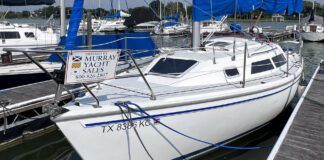
- Privacy Policy
- Do Not Sell My Personal Information
- Online Account Activation
- Privacy Manager
Timmerman Yachts is a Russian builder of quality luxury motor yachts. Based in Moscow, it is owned by a group of Dutch and Russian investors and operates out of Moscow Shipyard. Several noted naval architecture and yacht design firms are involved with Timmerman, including Vripack, Guido de Groot Design, Ginton Naval Architects, Jon Bannenberg Ltd., and Francis Design Ltd.
Founded in 2003, the company was named for 17th century Dutch boat builder Franz Timmerman who brought Dutch boat manufacturing techniques to Russia and co-founded the Russian navy. Timmerman Yachts has more than 1,000 employees working at the Moscow Shipyard.
Timmerman has delivered a number of semi-custom luxury yachts between 26-47 metres in length, including TM26 and Timmerman FD-51, designed by Francis Design Ltd. Other notable Timmerman yachts include Victoria M, Alexandra (now Latitude) and Olsten 125′.
One of the 10 largest yacht builders in the world, Timmerman is focused on building high-quality luxury yachts at more competitive prices. Its Russian-Dutch partnership provides great yacht-building capabilities. Timmerman builds yacht to the highest standards and holds DNV, MCA and Russian River Register certification. The company reportedly has more than a dozen yachts in some phase of construction.

Founded in 2003
Yachts built by Timmerman
Linssen 470 AC

General information
Description.

Icon RAGNAR 68m yacht charter
Overall information
PDF brochure
Yachts by ICON
Yachts charter ICON
Icon RAGNAR 68m
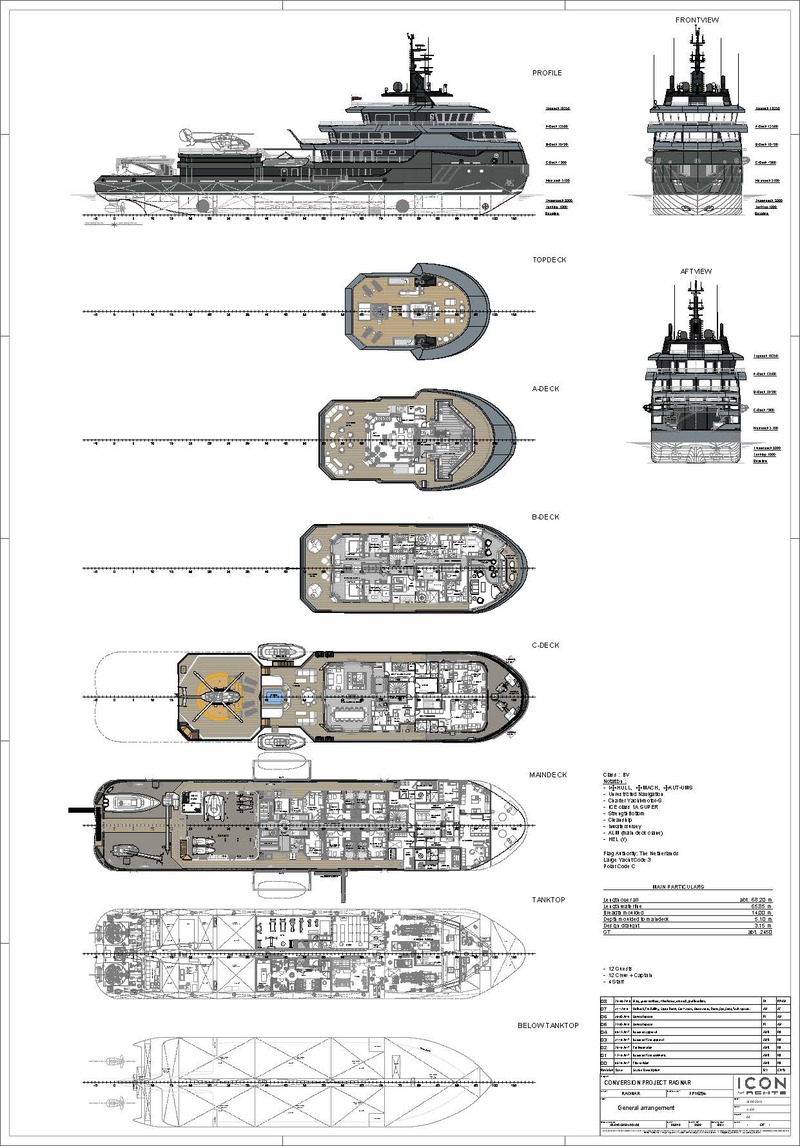

8 galley kitchen layout mistakes – and how the experts avoid them
G alley kitchen layout mistakes can turn what has the potential to be an efficient design for preparation and cooking into a hard-to-use space that makes tasks more difficult than they need to be.
While galley kitchen ideas are often the go-to for smaller homes, this is a layout that can equally work in a larger kitchen that’s part of an open-concept floor plan, but in either situation, it’s vital to understand what can go wrong with one of these layouts in order to steer clear of errors.
We asked kitchen design experts to share that knowhow and these are the galley kitchen layout mistakes they see made over and over, along with what to do so you don’t replicate them.
8 galley kitchen layout mistakes and their remedies
The galley is a popular choice among kitchen layouts because it can deliver on small kitchen ideas in compact narrow spaces and be a stylish choice for large, open rooms.
Two parallel lines of cabinets can make a small kitchen efficient with the layout taking its cue from the limited prep and cooking spaces of ships and airplanes, which nonetheless need to be functional. But the best layout for a galley kitchen might be a single line of cabinets in the narrowest of spaces. And in large rooms, a line of cabinets facing an island can create a distinct zone for cooking that nevertheless keeps the floor plan open.
But get them wrong and these sleek layouts can be less than ergonomic, and these are the traps to watch out for.
1. Failing to identify high traffic areas
It’s essential to identify which will be the busiest parts of a galley kitchen to avoid a layout error.
‘If you have a more limited floor plan the most important thing you need to think about is the spacing of appliances within your kitchen,’ says interior designer Hilary Matt, on behalf of Sub-Zero, Wolf, and Cove.
‘Where your appliances are, people usually are as well, so you don’t want to create any major flow issues by having all your appliances in the same area. In addition to appliances, consider where the sink and trash are located – these are two other high-traffic areas. This is particularly important in a galley-style kitchen layout because you only have one direction for traffic, so you don’t want to limit flexibility by having appliances directly across from each other.’
2. Neglecting lighting
It may be a limited area, but a galley kitchen needs kitchen lighting that’s as carefully planned as rooms with much larger square footage.
‘Address poor lighting, common in galley kitchens, by adding a balance of ambient task and accent lighting that makes the space bright but attractive,’ advises interior designer Artem Kropovinsky. The right lighting can make a small kitchen look bigger, too, and following the kitchen lighting rules and mixing different light sources makes every task easier and safer.
3. Going too narrow
However efficient a narrow kitchen layout a galley can be, if the space between the counters in a room with two lines of cabinets facing isn’t sufficient, there’s a problem.
‘At least 36 inches should separate the counters,’ says Hebe Hatton, head of interiors at Homes & Gardens . ‘But bear in mind that this is really only for kitchens used by just one person at a time. For kitchen sharers, a distance of 48 to 60 inches is preferable.’
4. Misallocating space
The work areas of a galley kitchen are precious, but are often used for other essentials, making preparation and cooking more awkward.
‘Most often, people lean towards symmetry and flank the back wall of the galley with the pantry and the fridge,’ says interior designer Nicole Cullum, founder at Color Caravan. ‘This takes up valuable cooking space and makes your beautiful new galley feel cramped and contained instead of open and airy.
‘To get the best use out of your kitchen, group your taller utility and appliances like your pantry and refrigerator on the wall perpendicular to your galley,’ she recommends.
5. Not working every inch
Like its nautical namesake a galley kitchen in a home should optimize the space available so compact doesn’t equal frustrating to use and cramped. ‘Make the most out of every inch in small kitchens,’ says Artem Kropovinsky. ‘Tall cabinets and pull-out drawers are innovative storage solutions to prevent clutter and maximize the space.’
Small kitchen storage that works the space hard can also include shelving and racks for walls, and dividers can be added to organize existing drawers and cabinets better.
6. Using an island for cooking
In a galley that consists of a single line of cabinets along the wall and an island, designing a kitchen island for cooking is a no-no, according to Nicole Cullum.
‘Take advantage of your back galley area to place your cooktop and sink as your main work area, leaving your kitchen island as prep and casual dining space,’ she advises. ‘Place your cooktop and sink at opposite ends of your back galley wall to maximize your workflow.’
7. Forgetting ventilation
A mistake Artem Kropovinsky sees made in galley kitchens is neglecting ventilation, which has unfortunate consequences. ‘Don’t forget about ventilation,’ he says. ‘A quality system ensures the air is fresh and that the kitchen remains cool, particularly vital in tight spaces.’
Poor ventilation can also result in odors hanging around, and it’s essential to have an effective exhaust fan – cooking without one of these is among the things people with nice-smelling kitchens never do.
8. Missing out on the contrast of light and dark
It’s tempting to go all-out with white in a galley kitchen, and it’s true that it can be very effective when designing a small kitchen. But bear in mind that contrast can help. Creating something for the eye to focus on rather than a sea of white cabinetry can make the space feel larger. A top tip would be to inject some contrasting shades at the sides of the kitchen, rather than the end of the galley to 'widen' the space and avoid it looking too tunnel-like.
‘Choose colors and materials wisely,’ advises Artem Kropovinsky. ‘By balancing light and dark shades, the illusion of space can be furthered in a galley kitchen.’
What are the disadvantages of a galley kitchen layout?
A galley kitchen can have some downsides. Because it’s often in a corridor-style space, a galley can feel tight; remedy this by including open shelving as well as upper cabinets, and using light reflective colors to visually stretch the space. This isn’t a problem when the galley is an open-concept floor plan, though. Like all small kitchens a galley could lack storage, so it’s important to maximize it using organizing solutions within cabinets and drawers and the full height of the room. Large appliances won’t fit into a narrow galley either, so size appropriately, and consider options such as dishwasher drawers.
Creating the best layout for a narrow kitchen is a design challenge, but galleys can be super-efficient as well as aesthetically pleasing. What’s more, a galley can be a great chef’s kitchen because it doesn’t require taking too many time-wasting steps. And with floor-to-ceiling kitchen storage a galley can provide all the stash space you’d want.
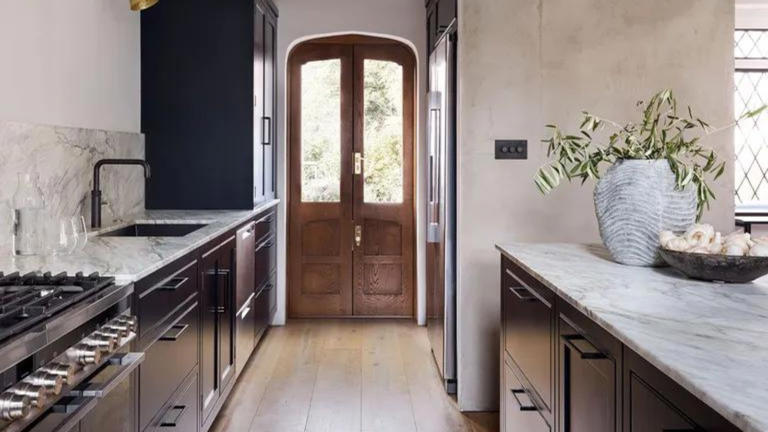
- Share full article
Advertisement
The Evening
Russia carried out one of the deadliest strikes of the war.
Also, polio vaccinations in Gaza are beating goals. Here's the latest at the end of Tuesday.

By Matthew Cullen
Two Russian missiles hit a military academy today in Poltava, a city in eastern Ukraine, killing more than 50 people and injuring scores of others, Ukrainian officials said. Ukraine’s president said a hospital had also been hit. It was one of the most lethal attacks of the two-and-a-half-year war .
Moscow has accelerated the tempo of its attacks in Ukraine over the last few weeks, resulting in a wave of death and destruction . Just yesterday, Russian forces fired a volley of missiles into Ukraine for the third time in a week.
The assault comes at “a moment when the war is more dynamic on the front, with Ukraine pushing into Russia and Russia pressing deeper into eastern Ukraine,” said my colleague Marc Santora, who has been reporting from Kyiv. So far, Ukraine’s incursion has not drawn Russian troops out of their advance, as Ukrainian officials had hoped.
After today’s strikes, President Volodymyr Zelensky renewed his pleas to Western allies for advanced air defense systems that can shoot down Russia’s ballistic missiles.
In Mongolia, Vladimir Putin received a red-carpet welcome . It was his first state visit to a member nation of the International Criminal Court, which has issued a warrant for his arrest.
The presidential election is 63 days away. Here’s the latest from the campaign trail.
Harris will put millions toward down-ballot Democrats
Kamala Harris’s fund-raising apparatus is planning to direct $24.5 million to organizations dedicated to electing state and local Democratic candidates, according to her campaign chair.
The fund transfer has been made possible by a surge of financial support for her candidacy after President Biden dropped his bid in July. The move also reflects the party’s increased focus on down-ballot races . Democrats were hit hard in local contests during Barack Obama’s presidency, and that allowed Republicans to redraw their legislative districts.
Here’s what else to know:
Harris is planning to propose a new $50,000 tax break for start-ups .
Trump’s aides evacuated their offices after listening devices were found. It was later determined that the devices were likely to be a prank .
Left-wing political misinformation is having a moment .
Do you have questions about the election? Send them to us, and we’ll find the answers .
Polio vaccinations in Gaza are beating goals
The campaign to vaccinate 650,000 children under 10 for polio in Gaza has been more successful than anticipated , according to the World Health Organization. Health workers have delivered vaccines to more than 160,000 children in the territory.
In Israel, protests and labor strikes erupted on Sunday after the military said that it had recovered from Gaza the bodies of six hostages who were previously thought to be alive. Prime Minister Benjamin Netanyahu has rebuked the protesters and refused to reach a compromise in the negotiations with Hamas.
U.S. commandos raided ISIS hide-outs
American and Iraqi commandos hunted down Islamic State fighters in bunkers over miles of remote terrain in western Iraq last week, killing at least 14 in one of the most sweeping counterterrorism missions in the country in recent years.
U.S. officials said that the operation underscored the terrorist organization’s resurgence in recent months. However, Iraq and the U.S. are now negotiating a plan to wind down the U.S.-led military mission in the region.
More top news
Democratic Republic of Congo: At least 129 people died during an attempted jailbreak at the country’s largest prison, the authorities said.
France: At least 12 people died after a boat carrying migrants trying to cross the English Channel capsized off the northern coast.
F.B.I.: Agents arrested a former deputy chief of staff to Gov. Kathy Hochul of New York and charged her with acting as an illegal agent of China.
Albania: Local landowners are questioning how Jared Kushner and Ivanka Trump were able to sew up development rights for two luxury hotels on hot coastal property .
Venezuela: With the nation’s democracy in shambles, President Nicolás Maduro declared that Christmas would begin in October this year .
Diplomacy: John Podesta, President Biden’s top climate diplomat, is traveling to China .
Business: Hewlett Packard will continue to pursue civil fraud damages of up to $4 billion from the estate of Mike Lynch, the British software mogul who died last month when his yacht sank.
Health: Some researchers are rethinking addiction as a chronic brain disease .
Sports: The U.S. Open is busier than ever, and some fans aren’t happy about it .
Titanic: New photos show that the ship’s famed bow has been damaged .
TIME TO UNWIND
The secret weapon behind pop’s next generation.
Two of the most memorable lines from this year’s Top 40 hits came from Sabrina Carpenter’s breakout album, “Short n’ Sweet.” One is a chorus ending with an endearing expletive, and the other is the nonsensical phrase “that’s that me espresso.” The lines, created — like the rest of the album — with the help of the songwriter Amy Allen, are jolts of idiosyncrasy that were largely absent from pop music until recently.
Allen has become a fixture in pop’s A-list backrooms after years of hustling in every corner of the industry maze.
Do you have healthy brain habits?
Jonathan Rosand, a neurologist in Massachusetts, is often asked by patients what they can do to reduce their chances of developing a neurological disease. To answer the question, he and his colleagues came up with a questionnaire that they say can help predict people’s risk for developing dementia, stroke and depression later in life.
The good news is that it’s possible to make lifestyle changes that can improve your score on every question. You can take an adapted version of the quiz here .
Dinner table topics
Alvin Ailey’s sparkle: The choreographer is the focus of one of the most ambitious shows the Whitney Museum has ever presented .
Whale festival: Every year, when thousands of humpbacks return to their breeding grounds in Colombia, locals gather to serenade them .
Office retreats: A place to relax is becoming a hallmark of creative workplace design .
Funnel-cake macchiato: Coffee shops are competing to see who can come up with the craziest, calorie-laden, not-really-coffee drink .
WHAT TO DO TONIGHT
Cook: Meal planning can be tough. We came up with 100 easy and delicious dinner recipes .
Watch: Stream these shows and movies before they leave Netflix this month .
Read: Rachel Kushner’s “Creation Lake” is a smart and sinuous espionage thriller .
Tend: Here’s how to take care of a tattoo .
Style: Yes, you can pull off a jean jacket .
Learn: We asked experts for tips on becoming more resilient .
Compete: Take this week’s Flashback history quiz .
Play: Here are today’s Spelling Bee , Wordle and Mini Crossword . Find all of our games here .
ONE LAST THING
Taking back the streets (for recess).
From stickball to double Dutch, playing in the street has long been a rite of passage in New York City. Now, a new city program is offering schools the authority to close streets to traffic and open them as a safe place for students to run around during recess .
This month, 71 streets are being taken over by children who are otherwise confined to a building. “They were so happy to be able to go outside, burn some steam and just have, like, that old-school feel of being able to go outside and enjoy yourself during lunch time,” one community school director said.
Have an energetic evening.
Thanks for reading. I’ll be back tomorrow. — Matthew
Philip Pacheco was our photo editor today.
We welcome your feedback. Write to us at [email protected] .
Matthew Cullen is the lead writer of The Evening , a Times newsletter covering the day’s top stories every weekday. More about Matthew Cullen

IMAGES
VIDEO
COMMENTS
Boat Galley Layout. The shape and layout of your space will dictate how you set up your kitchen and arrange your boat galley accessories. Three standard layouts for a boat galley exist - Linear, L-Shaped, or U-Shaped. L-Shaped and U-Shaped galleys are more commonly found on offshore cruisers, as the design provides more support and security ...
This layout promotes efficiency by minimizing the distance between these areas, making it easier to move between tasks. 2. The Galley Layout. The galley layout is a popular choice for boat galleys, as it makes the most of limited space. This layout features two parallel countertops, with appliances and storage on both sides.
At 20 square metres, the galley on board the Tankoa superyacht Bintador is "probably the biggest you can find on a 50-metre yacht," the owner's project manager, Giancarlo Mussino, said. A central island seats six people. Having a sizeable, sociable galley was a mandatory request from the owner, according to Giuseppe Mazza, sales and business development manager of Tankoa.
Above: The stylish galley onboard the 2021 42 Cantius by Cruisers Yachts features clean lines and an open air design that provides an effortless entertainment area with ample storage, a microwave/convection oven, sink with spray faucet, 32″ flat screen TV and refrigerator/freezer. Photo via Cruisers Yachts and MarineMax in Pompano Beach, FL.
A 25′ boat obviously has a lot less space available for the galley than a 50-footer does. But that doesn't mean that the 25-footer can't have a workable galley and a reasonable amount of storage. One thing to note on all boats is that the majority of your storage space for provisions won't be in the galley — it'll be under the ...
The Social Galley. Recent yacht design has emphasized placement of the galley so that the cook(s) can socialize with those in the main saloon. On a small boat, where dinner might be service for four, this arrangement can work nicely. ... Perhaps the most common galley design, seen here aboard a Union 36 (left), is the U-shaped, port-side setup ...
Foodies rejoice: cooking on board is taking centre stage, says Tory Kingdon as she discovers the design trends shaping superyacht galley kitchens in 2021. Once upon a time, the galley was a somewhat overlooked element of a superyacht's general arrangement and design. Primarily used by crew, they would be installed as a rather uninspiring ...
The yacht galley is a technical space; its purpose being to facilitate one of the most important onboard activities: the enjoyment of good food and good company. There are, of course, specific design/layout needs dictated by the vessel's type and size: motor versus sailing, under 100 feet versus over 100 feet, the time spent at sea and in ...
Boat and yacht galleys and home kitchens are both used for preparing meals, but the similarities end there. Call the food prep area of a boat or yacht a "kitchen" and you'll be exposing yourself as a nautical newbie, because on boats the kitchen is always called the galley. And upon close examination, galleys are among the most ...
A Good Working Layout for the Boat Galley Cooker, fridge, sink and worktop arrangement in a practical galley arrangement The three main units - cooker, sinks and refrigerator - should be close together so that the cook can reach all three without having to move more than a step or two, which is more easily achieved with a U-shaped or L-shaped ...
Though the galley has always rated key consideration in sensible yacht design, changes over the last 25 years on the domestic front are influencing changes in the galley design, says Gerry Douglas of Catalina. "It's similar to what's happened in houses," says the Catalina corporate vice president and head of engineering.
With minimal space, it's vital that a Superyacht galley is designed effectively. GN-Espace Systems specialise in yacht galley designs and are here to discuss how to make galleys better. As shipyards and owners compete with each other to build the largest Superyacht, it is fair to say that the general mood amongst yacht chefs is a positive one.
Galley down provides a private, self-contained galley with dedicated prep areas, which is ideal for chefs on charter boats. Some chefs contend that at the heat of the moment, they want to cook, not socialize! Private owners also like this in-hull galley design because it frees up the bridgedeck for an open, clean, and more spacious saloon area.
Use the drawing as a starting point for your own design. The construction I suggest goes as follows. For the main structural panels of sides, top, and bottom, use 3/16" or ¼" waterproof plywood. For backing the joints use 3/8" or quarter round, as shown in the drawing. Brass brads and epoxy adhesive would be a good combination for ...
When guests are on board, the galley is the busiest room on a yacht. The better these areas are designed the better the guest experience will be while pushing an expensive galley refit back by a number of years. Hit the play button on the video directly below to see a 140m Owner Galley that is currently in production. If you want to see more ...
Yacht Galley Design. Elevate your culinary experience onboard with our expert yacht galley design services. From concept to completion, our team of experienced designers and craftsmen will work closely with you to create a galley that perfectly balances style, functionality, and efficiency. Whether you're a gourmet chef or simply enjoy ...
Timmerman. Timmerman Yachts is a Russian builder of quality luxury motor yachts. Based in Moscow, it is owned by a group of Dutch and Russian investors and operates out of Moscow Shipyard. Several noted naval architecture and yacht design firms are involved with Timmerman, including Vripack, Guido de Groot Design, Ginton Naval Architects, Jon ...
The boat has three levels, due to this, the area of habitat increased significantly. The layout of a residential deck provides two twin cabins that can be double or single space. Cabins are equipped with private bathrooms. Interior residential deck also includes REC room with sofas, a small dining area and galley.
Polish shipyard Galeon will be present at the Moscow Yacht Show with two yachts - 360 Fly and 420 Fly. Both yachts offer more than you would expect from these size categories. The 360 Fly managed to accommodate three passenger cabins in its 11.3-meter hull. In addition to the three below ground cabins, the 420 Fly has a generous size flybridge with galley and al-fresco dining room ...
Leningradskoe highway 39, build. 7, Moscow, Russia, 125212. Tel: +7 (495) 937 90 00. Ukraine
Galley kitchen layout mistakes can turn what has the potential to be an efficient design for preparation and cooking into a hard-to-use space that makes tasks more difficult than they need to be ...
Business: Hewlett Packard will continue to pursue civil fraud damages of up to $4 billion from the estate of Mike Lynch, the British software mogul who died last month when his yacht sank.